![]()
![]()
The flower sellers and the popcorn venders were having a field day. The streets were jammed with traffic diverted from the University. Sales would be good.
 A range of different modes of transport plying Dhaka streets, makes the city roads difficult to negotiate. ? Shahidul Alam/Drik/Majority World
A range of different modes of transport plying Dhaka streets, makes the city roads difficult to negotiate. ? Shahidul Alam/Drik/Majority World
Dhaka University turned into a cantonment,’ said Rahnuma’s text message. I was hurrying to the CMM court in Old Dhaka where the trial of the university teachers was taking place. As I pedaled through the gaps between cars, rickshaws, CNGs (gas run three wheelers) and thalagaris (push carts) I felt glad I was on a bicycle.
 Dhaka University teachers leaving the CMM court in Old Dhaka. ? Shahidul Alam/Drik/Majority World
Dhaka University teachers leaving the CMM court in Old Dhaka. ? Shahidul Alam/Drik/Majority World
Ocassionally biking along the footpath, not strictly legal, I was slowed by the vending stalls and bus ticket counters that had sprung up. Legality was not such a big thing here.
 Bus ticket sellers in New Elephant Road. ? Shahidul Alam/Drik/Majority
Bus ticket sellers in New Elephant Road. ? Shahidul Alam/Drik/Majority
Last night, the guards had caught a guy stealing copper cabling. The thief was a “heroinchi”. They had roughed him up and let him go. Taking the guy to the police wouldn’t have helped. The police would have got richer and the guy would be out stealing again. People take law into their own hands. Bribes are common-place, violence is normalised, nepotism is ripe. Despite the rhetoric at the top, abuse of power is the order of the day. But there is a sub-text. It was wrong of the heroinchi to have stolen the cable, for me to have used the footpath, for the vendors to have taken over public pathways, for the policeman to have taken bribes. Except in my case, there were mitigating circumstances that made all of the other acts less of a crime. The heroinchi had his addiction to blame. The vendors had no other place to go, police salaries were impossible to live on. They might have found other solutions, but they broke the law instead. Unlawful, but not sinister.
I saw other things along the way. The policeman in Gulistan Mor puncturing the tyre of a rickshaw walla caught on a road reserved for cars.
 Policeman with needle used to puncture rickshaw tyres. ? Shahidul Alam/Drik/Majority World
Policeman with needle used to puncture rickshaw tyres. ? Shahidul Alam/Drik/Majority World

Policeman beating up rickshawalla. ? Shahidul Alam/Drik/Majority World
 Policeman controlling traffic at Nawabpur Road. ? Shahidul Alam/Drik/Majority World
Policeman controlling traffic at Nawabpur Road. ? Shahidul Alam/Drik/Majority World
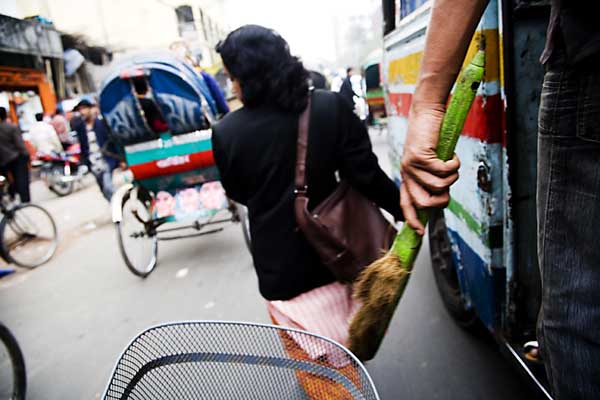 A bus conductor uses a brush handle to beat off nearby rickshaws or other ‘low grade’ traffic. ? Shahidul Alam/Drik/Majority World
A bus conductor uses a brush handle to beat off nearby rickshaws or other ‘low grade’ traffic. ? Shahidul Alam/Drik/Majority World
A policeman on Nawabpur Road, punching a rickshaw walla for some other reason. True, rickshaw wallas don’t always obey the law. But no policeman would have punctured the wheel of a car. No drug baron would ever be roughed up, no hotel owner would ever be shooed off his establishment.



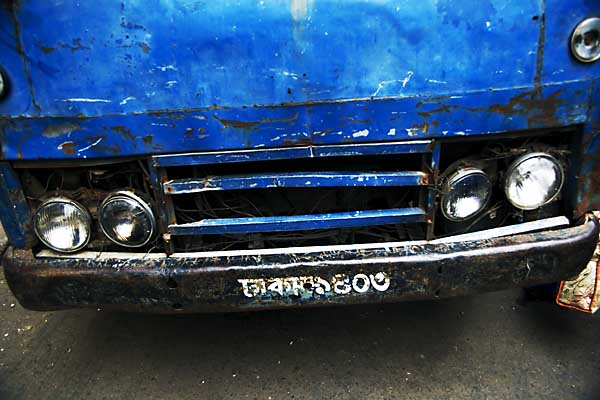 Dilapidated police prison vans outside CMM court. ? Shahidul Alam/Drik/Majority World
Dilapidated police prison vans outside CMM court. ? Shahidul Alam/Drik/Majority World

Military microbus by ‘no parking’ sign near Rapa Plaza in Dhanmondi. ? Shahidul Alam/Drik/Majority World
Few police cars would ever pass a fitness test. The more swank olive green cars, parked illegally, would never be challenged. When power is flouted with such abandon, corruption seeps to all levels. Ordinary people are simply too small to challenge the system. The rule of law must apply to all if it is to work. When the ruling party cannot be challenged, when a military rank gives total authority, when being in power means laws no longer apply, the law of the streets becomes the law of the land.
Much has been said about the students’ protest on campus in August 2007. Little has been said about the cause of the incident. The military cannot occupy a university campus in a free land. It is the duty of any self-respecting student, of any citizen, to challenge such army presence. The arrogance of the soldiers might have aggravated the incident. Their long held belief that they are above the law, surely led to the brutality that followed. But the original crime was one of occupation. And occupation, wherever found, must be resisted.
Why should university students bow to injustice? What values can future citizens uphold having silently accepted the loss of their freedoms? How can a teacher teach knowing he has turned his back to wards being illegally victimised?
 The back door of a prison van waiting outside CMM court. 21st January 2007. ? Shahidul Alam/Drik/Majority World
The back door of a prison van waiting outside CMM court. 21st January 2007. ? Shahidul Alam/Drik/Majority World
To convict and then provide presidential pardon, is an act of self-deification by the government. Those with less clout will continue to languish in jail. A dark and violent jail they should never have entered. If the judiciary be truly independent, then it should call to the docks those who ordered a military occupation of our university. It should bring to trial those who use emergency rule to torture our citizens and muzzle the media. It should penalise those who judge others without subjecting themselves to scrutiny. The rule of law is essential for society to live without fear. For it to apply, it must start at the top.
Category: Bangladesh
Unruly Images
Masculinity, Public Memory and Censorship
By Rahnuma Ahmed
Because it can be neither forgotten nor redeemed, the past must be changed. To redeem the past one must alter one’s relationship to it… If the problem.. [is that] of a one-dimensional political representation, then what it calls for is not work on the subject — or not just that — but… “political work on the symbolic.”
Linda M. G. Zerilli, The Abyss of Freedom.
Bissrinkhol Drissho: Pourush, Public Smriti O Censorship attempts to do that. To politically work on that which is symbolic. It came out recently, as a small booklet. My article is prefaced by a foreword written by Abdullah al-Mamun, who teaches Mass Communication and Journalism at Rajshahi University. He was released from prison nearly six weeks ago, alongwith three other teachers, Moloy Kumar Bhowmik, Dulal Chandra Biswas and Selim Reza Newton. They were granted presidential clemency on 10 December 2007. Incidentally, neither the teachers, nor their wives, had appealed for a presidential pardon.
They have been released from prison, but not from the farce that the government is carrying out with public university teachers, students and employees. The clemency covers conviction and punishment, but the government has not withdrawn the case against them. Mamun and the others appear in court on January 28, when appeal hearings begin.
The newly-appointed education advisor while talking to news reporters about the case against Dhaka university teachers, unwittingly exposed the farce. “Whatever be the verdict,” he said in all seriousness, the teachers will be “released soon.”
Whatever be this week’s outcome, these famous last lines will not be easily forgotten.
Not a straight-forward affair
Photographs. And people. The connection is not a simple one. `Hey, I didn’t know you had gone to Rajendrapur?’ `Just that once, the picnic was terrible.’ Photographs capture a particular moment, but to know whether that moment is something out of the ordinary, whether it represents a whim or a regular habit, we need people. We need testimony. Thus, what a photograph can tell us has its limits. Documentary photographs, at times, may not give us the feeling of recognition we expect, “Is that you? I would never have guessed.” Sometimes they may be pretty inaccurate. Also, there is the question of interpretation. “Hmm, looks like the two of you had snuggled up real close…” “No, no it’s the angle, he was at least five feet away.” As I said, the connection between people and photographs is not a straightforward affair.
Mishaps may happen. Ordinary people may feel piqued on seeing the results, “The light wasn’t good” or, “She’s a lousy photographer,” but rulers are less likely to take them kindly. Specially, if it unravels carefully-constructed identities. Group identities of patriotism and disinterested professionalism. Identities crucial to legitimising. Identities essential for individual ambitions.
Censorship is often thought of stereotypically. As a prohibition, a ban on disclosure. Mamoon, in his foreword to Bissrinkhol Drissho (henceforth Unruly Images) argues differently. He writes, censorship is relational. It is oppositional. Desired images, destined for circulation, are continuously produced and re-produced while undesirable ones are stifled. Both occur simultaneously to construct a reality that meets the expectations of rulers.
Dhaka University incident: unruly images
Unruly Images is about the regime of visual images, not flesh-and-blood people. In it I take a close look at two photographs generated during the Dhaka University protests of August 2007. The military-backed caretaker government came to power in January 2007. Soon after, a perceptible change took place in the world of visual representations, in the world of images. Military masculinity came to be foregrounded as a distinct form of masculinity, in opposition to civilian masculinity, its silent other. TV, both government and private channels, and the print media were the primary instruments used to effect the change. The act of foregrounding re-drew the difference between civilian and military as a primary one, something qualitatively different to the multiplicity of competing masculine images, leader, cadre, executive, mastan, businesman etc seen during the period of elected governments, 1990-2007. In military song video performances regularly screened on TV, military masculinity is portrayed as infinitely courageous, whether on the training ground, in the battle for liberation, or soldiering for peace in faraway lands. The army uniform emerges as a symbol of discipline, regularity, order, control, restraint, punctuality. In writing this, my concern is not with its truth, it is solely with images, with portraiture. The song-video images lack social depth. There are no folds, no seams, no hesitancies, and as such, they are propagandistic. Being fragile, they are unable to withstand the realities of life. They falter if not propped up by the state. Their fragility grieves the creators, their grief and pain is expressed in language founded on the state’s powers of coercion. As happened in the case of Dhaka University, in August 2007.
The publication of the first photograph, the censored one, created disorder in the world of images. To restore order, it became necessary to introduce the second image, Professor Anwar Hossain’s apology to the armed forces. This image was generously circulated, distributed and re-distributed, over and over again. The times however were tumultuous, one event rapidly followed the other. That the two photographs are linked, in a cause-and-effect fashion, was something overlooked. Looking at one image brings back memories of the other. It was an oversight. Such things do happen, even with the best of intentions.

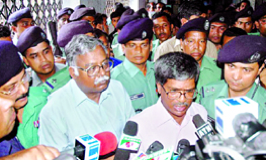
If the first image is censored, how does one talk about it? How do I convey to readers what is in the photograph? How does one manoeuver around censorship restrictions?
Three sources exist, highly reliable sources, not-censored sources, that offer us a language to talk about them. One is Professor Anwar Hossain’s statement itself, a primary text, an authentic one since those to whom it is addressed have not raised any objections. Of the other two sources, one is to be found on the Bangladesh armed forces website (Dhaka Bisshobiddaloyer Shongothito Opritikor Ghotonatir Itikotha); the other is also military, but un-official http://www.bdmilitary.com/.
In Professor Anwar Hossain’s statement, one comes across the lines of opposition: army/military versus civilian. Civilian is expressed through different words, “students,” “Dhaka university,” “teacher,” “General Secretary of Dhaka University Teachers Association” ” guardian of the students.” These words give us an idea of place, time, the actors involved. A happening seems to have occurred, one that involves action and reaction. Professor Anwar mentions the word “attack” five times. I assume, from the logic of the apology offered, that a student has attacked a member of the army. The nature of the attack? The title of a BMF report found on its website indicates an unarmed attack, The “Flying Kicker” Identified (for those who don’t know, Bangladesh Military Forces Group is an independent, non-governmental, non-political and non-profit association of research on defence and strategic issues). “The” and “Kicker,” are telltale words that indicate one student, not many. Other words indicate one army member only, “an attack on a member of the army means an attack on the armed forces, as a whole”. He must have been in uniform, or else why would Professor Hossain say, “The agitated students even attacked [members of the] army in uniform” “If anyone attacks the uniform of a member of the army…”
I find the elision between “uniform”, “a member of the army”, and “the army as a whole” in Professor Hossain’s statement, and in the other sources, breathtaking. The elision is re-inforced in the mapping-out of the army: from the ordinary jawan at the lower rungs, to the army chief at the top. Map the text on to the image and one gets frightening results, a student becomes representative of Dhaka University as a whole, of the civilian sector as a whole. A hapless member of the army becomes representative of the army as a whole, of its honour and respect. In the process, a particular meaning gets attached to the army — the lack of courage. Images of valour and courage present in the war of liberation in 1971, in UN peacekeeping missions abroad, recede.
Why were the words that spoke of the students’ self-respect, the ordinary peoples self-respect censored? Why was Professor Anwar allowed to make a statement to the press? After all, he was in remand (allegations of physical and mental torture). Why was the elision permitted? It only serves to fracture national unity on civilian vs miltary lines.
The events at Dhaka university speak of a story of humiliation. Of revenge. Of arrogance and ill-conceived strategies. Of unintended consequences.
Keeping the lamp lit
![]()
![]()
The newly appointed education adviser has my sympathy. He had spoken the truth. With scandals emerging about departing advisers, and accusations flying about the gross incompetence of the ‘PhD’ government, he must have felt the need to demonstrate the character of the cabinet.
Having lost the Candy Man, we now have an adviser who is candid in his remarks. “Regardless of the verdict of the court, the teachers shall be freed, ” he had said. Great news for the teachers. Sad news for justice.
But the candor of the education advisor is unlikely to inspire confidence in the government. He might equally have said, “regardless of the verdict of the court, we shall find Sheikh Hasina and Khaleda Zia guilty,” or any other convenient outcome for the many flimsy cases against politicians, business people, students or any other member of the public. The fact that the government finds the judicial system irrelevant, while confirming people’s fears, does do away with their flicker of hope for justice. This was a lamp that needed to stay lit.
The anniversary party could have done without the media gatecrashers. The weeks leading up to the 11th January 2008, have been particularly difficult for the government. In August, it had taken violent protest by the students for the military presence in campus to be removed, but it is the fallout of the government’s heavy-handed response that they now need to deal with. Having closed the 24 hour news channel CSB
 24 hour CSB News TV channel after its closure. Dhaka. Bangladesh. ? Kakoli Prodhan
24 hour CSB News TV channel after its closure. Dhaka. Bangladesh. ? Kakoli Prodhan
and intimidated others with barely veiled threats, they had expected an easy ride. But they had reckoned without the spunk of Bangladeshi media. BTV has long since become irrelevant. Cheek in jowl, private channel media activists have found creative ways to get the news to the public, and an informed audience has responded. I remember the phone calls ‘from above’ that came in while a talk show was going on. The savvy presenter responding smartly toned down his own questions, letting me speak as I pleased. It was a live show, and he could hardly have been blamed for the words I was using. The phone calls to the editor, the ‘invitations to tea,’ and the physical presence of army personnel have made honest reporting a harrowing task, but the news programmes are alive and well, and while they have economic pressures, they retain a loyal following.
Even newspapers that had decided to ride in the comfort of the military train are having to make face-saving critiques of a government facing derailment. It is the government, which is on the back foot. CSB is still closed, but the phone in callers, the letter writers, the bloggers and the talk show speakers have joined in the fray. This is media at its best.
Amnesty’s Secretary General, Irene Khan, made up for her initial failure to denounce emergency rule, “Amnesty believes that the government can waive some of the restrictions, even under emergency rule.” The media again had set the tone. She was far more forthright in the latter stage of her visit and pointed to the ubiquitous presence of the military in all public spheres, clearly stating that military rule was unacceptable.
I could smell the stench of decomposed flesh as I walked up the stairway of the partially demolished Rangs Building.
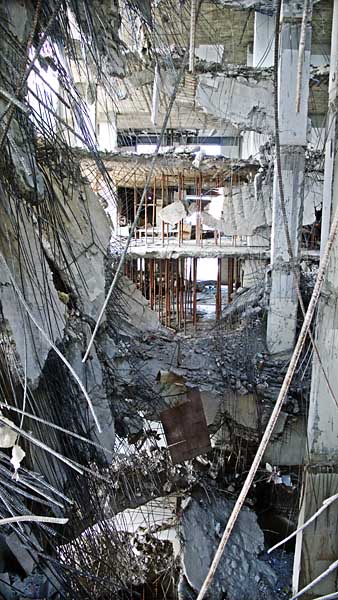
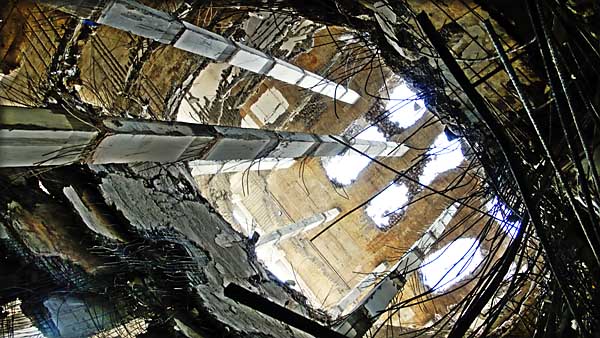
Loose concrete slabs and boulders still dangle precariously from the remaining metal rods of the Rangs Building. ? Shahidul Alam/Drik/Majority World
 Even in this unsafe condition, and while the body of a security guard is still buried under the rubble, workers remove rubble from the partially demolished Rangs Building. ? Shahidul Alam/Drik/Majority World
Even in this unsafe condition, and while the body of a security guard is still buried under the rubble, workers remove rubble from the partially demolished Rangs Building. ? Shahidul Alam/Drik/Majority World
The Rajuk administrators were themselves scared to be there, but being government officials they had little choice. They pointed me to a staircase that was relatively safe. Workers, not having my benefit of class, climbed the more dangerous ones. I wonder how it feels to walk past a deceased colleague, past the stench, the rubble, past rickety columns. What is it like to know one’s death will only matter to one’s nearest ones.
Yesterday police turned their batons on garment workers demanding outstanding wages and fires yet again engulfed city slums.
 Fire in Rayer Bazaar slum destroyed around 2500 homes. January 12 2008. ? Munir uz Zaman/DrikNews
Fire in Rayer Bazaar slum destroyed around 2500 homes. January 12 2008. ? Munir uz Zaman/DrikNews
 Garment worker killed by collapse of factor building. ? Shehabuddin/Drik/Majority World
Garment worker killed by collapse of factor building. ? Shehabuddin/Drik/Majority World
The recent deaths of other garment workers and general demands to receive an acceptable minimum wage, all point to the disengagement from the public of a caretaker government that has failed to care.
We are in need of honest answers, and while the new education adviser revealed the government’s complete disregard for the judiciary, I suspect his honesty was the unintended byproduct of yet another exercise in spin. If on the other hand, his admission of the irrelevance of the judiciary was the beginning of a process of transparency, unpleasant though the truth might be, I welcome it. Admission of guilt does not in itself solve the problem, but it does begin to address it. Something they have so far singularly failed to do. They have blamed the ills of the nation on politicians and political parties. On bad democracy. The people are in no illusion about the improprieties of the past. But bad democracy can only be replaced by good democracy. There is no such thing as good autocracy, and pliant front men, no matter who they are backed by, can never be an answer.
Freedom of Expression Roundtable
Amnesty International launches Bangla website and discusses freedom of expression in Bangladesh
8 January 2008
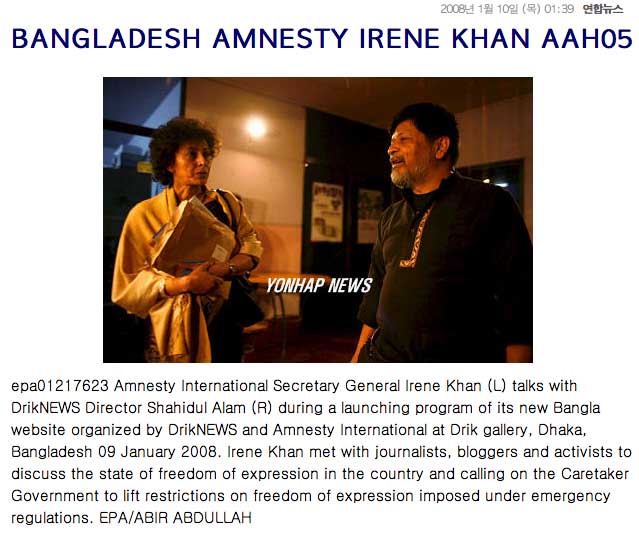 Feature on Korean media
Feature on Korean media
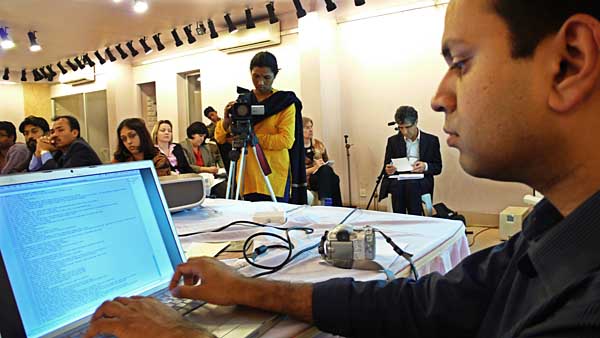 Asif Salef of Drishtipat, uploading the live text stream (text provided below). ? Shahidul Alam/Drik/Majority World
Asif Salef of Drishtipat, uploading the live text stream (text provided below). ? Shahidul Alam/Drik/Majority World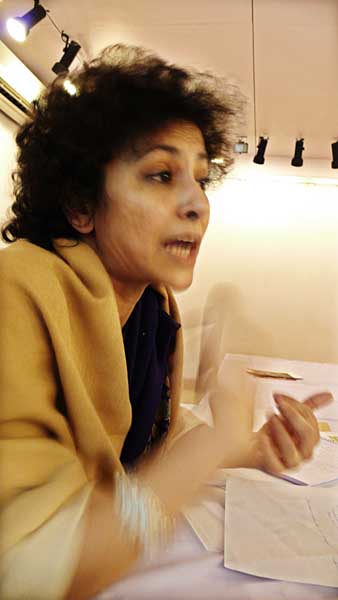 Irene Khan, secretary general of Amnesty International speaking at the “Freedom of Expression” roundtable at Drik. ? Shahidul Alam/Drik/Majority World
Irene Khan, secretary general of Amnesty International speaking at the “Freedom of Expression” roundtable at Drik. ? Shahidul Alam/Drik/Majority World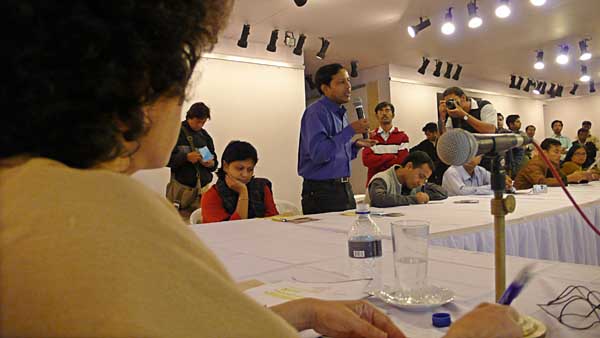 Journalist Jahangir Alam Akash talking of being tortured by military while pursuing an investigation. ? Shahidul Alam/Drik/Majority World. In an email Jahangir informs us: yesterday night, police went my previous house of uposhahor in rajshahi for arrest me, when i attend in a roundtable in dhaka in presence of amnesty international secretary general irene khan.
Journalist Jahangir Alam Akash talking of being tortured by military while pursuing an investigation. ? Shahidul Alam/Drik/Majority World. In an email Jahangir informs us: yesterday night, police went my previous house of uposhahor in rajshahi for arrest me, when i attend in a roundtable in dhaka in presence of amnesty international secretary general irene khan.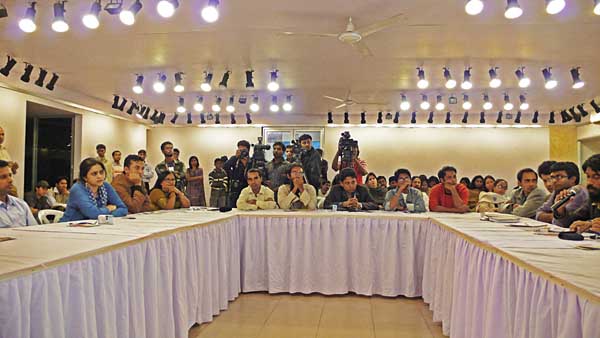 Participants at “Freedom of Expression” roundtable at Drik on 9th January 2007. ? Shahidul Alam/Drik/Majority World
Participants at “Freedom of Expression” roundtable at Drik on 9th January 2007. ? Shahidul Alam/Drik/Majority World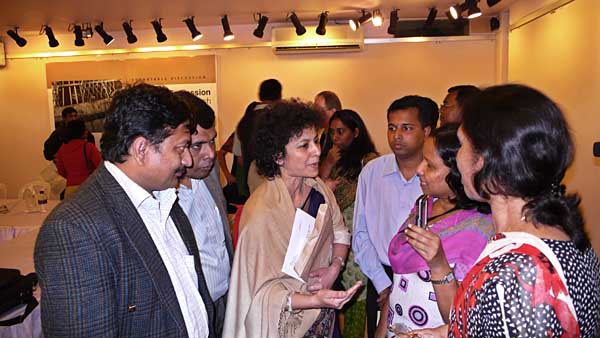 Irene Khan, secretary general of Amnesty International speaking to participants at the “Freedom of Expression” roundtable at Drik. ? Shahidul Alam/Drik/Majority World
Irene Khan, secretary general of Amnesty International speaking to participants at the “Freedom of Expression” roundtable at Drik. ? Shahidul Alam/Drik/Majority WorldTranscription by Asif Saleh/Drishtipat
Thanks to the technical team who helped set this up.
=========
greetings
the secretary general of amnesty international irene khan is with us
Shahidul Alam introducing
Irene Khan is not only a Bangladeshi but also first muslim woman head of Amnesty
We will have this show in a different format than usual
This will be a discussion and not room for speech
We want to create dialogue
Shahidul thanking all.
Irene introducing speech with a history of Amnesty
Irene talking…when I am in bangladesh from higher level it seems there is a lively media
But there must be another story
I met the army chief today and expressed my views about freedom of expression
For years now we have picked up a steady stream of journalists who have been attacked and wounded
In times of change we desperately need room for freedom of expression.
I am going to try get a complete picture from every one.
Shahidul now saying we are going to try to keep the discussion small
My name is Akash
I used to work for CSB new
The roundtable is very important for me
I want to get a little bit of time for myself.
because my rights have been severely hampered
Akash describing the story of how his rights were violated
I reported a story in CSB news when a father was shot by RAB infront of his daughter and I got persecuted for this.
Akash describing the process in details….how he has been fleeing for 3 months
he has been living a crippled life for the past 3 months
The oppression that happened to me
Akash has broken down in tears
Describing the judicial process.
Even though the high court has given him bail but still the local court still has issued a warrant against me.
There may be a lot more Akashes out there
Jahirul Huq Tito , Manik Saha to name a few over the years.
I want to live a free life
I want to go back to my profession.
and work for humanity
I want to dream of a new Bangladesh…I don’t want the oppression that has happened against me to happen to any body else,
Irene is speaking
We knew about your case
When you were in detention, I explained your case very forcefully to the foreign adviser.
You said that you do not want justice but just want to live and that shows the desperation of the case.
I want to assure you that Amnesty will do every thing they can.
parvin Sultana asks whether irene feels that we have press freedom in Bangladesh
sanjib drong of adivasi forum speaks..
Describes the case of Cholesh Richil..who was killed on March in Modhupur.
by the joint forces
The killing on the indigenous community is always justified.
I want to request you to take up the case of cholesh richil and follow through.
The perpetrators know that if indignous leaders are killed then nothing happens and that is only going to encourage more killing
I would like Amnesty to find out at what stage the investigation reports are held
Irene speaks.
Irene: We have already picked up the case and already spoke to high level cases.
High level admins
There has been no prosecution on the case
A crime has been committed but no justice has been serveed.
Pavel partha speaks
I want to highlight the violence of the multinational companies.
Companies like Monsanto ..
Our natural resouces are being stolen,
cases like Phulbari is an example of what multinationals can do in the name of progress
Corporations are violating our rights
we want to know what Amnesty can do to highlight this…
Faruq Wasif of Prothom Alo speaks
thank you irene..
Your coming to Bangladesh and solving individual cases are not the solution
we want to highlight the case of 1971….Amnesty was silent during the war of 71
Similarly your stand in this visit was very mild.
Doesn’t it show a very tolerant view of Amnesty towards military regimes?
Omi Rahman Pial speaks from bdnews24…
I am a blogger
What is the limit of my work?
I see Akash in front of me and I fear what may happen to me and what I need to do so that it doesn’t happen to me?
We have lots of irregularities and working under lots of pressure…
I can’t publish news at the right time because our internet will be brought down , calls will be made etc.
Jornalist from Samakal
We are living in an era of depression rather than free expression
I want to hear from Irene — how is she explaining Bangladesh’s current state.
I want to understand the total role of Amnesty in current Bangladeshi situation.
Anisur Rahman from New Age speaks
Cholesh is from my village
Cholesh was a symbol of free expression as well.
Cholesh used to speak for others in the community.
That’s why Cholesh was targetted
They tried not to kill the person Chalesh but silence a whole community.
Garments workers are not getting their salaries but when they are protesting, they are being taken to court.
Also want to highlight the case of tasneem khalil
We don’t know where he is today,
He was a blogger and a journalist at Daily Star.
We are seeing freedom of expression only for a few folks in certain commissions of the government.
He is now talking about some inconsistencies on tax loop holes
not sure..why 🙂
those who are on the web…this is not alam…but asif.
Shahidul asks to keep things shorts
Biplab Rahman , a blogger and journalist speaks
highlights internet monitoring.
telephone tapping
I have done a lot of research on Chittagong Hill tracks
and I want to highlight why mobile network is not there is those 3 disrticts
Therer were towers placed by the telecom companies but it was taken down by the local armed forces
I wanted to highlight the cases of university teachers as well…and think they should be released
Tipu Sultan from Prothom Alo speaks.
The journalists outside Dhaka lives under severe restriction
All the news are screened by authorities
They can not send the news of fertiliser crisis because of joint forces restrictions
They regularly face the threat of extortion cases from the local forces
But the authorities in Dhaka know this but they still deny it.
BUt the Dhaka journalists are doing much better compared to them.
Yesterday there was a case like that in Thaurgaon.
Udisa Islam speaks
Freelancer ..used to be in tv
Another introduction of mine is — I am the wife a teacher who were detained in Rajshahi University,
I am hearing a lot of sad stories..
but what is the worth of presenting this here?
We need to share this stories with each other ALL the time
This I am saying as a grassroots journalist,.
Last Aug 22nd whatever happened in bangladesh, everyone knows
Similarly whatever happenned with the museum statues.
The media played a brave role there.
How were those published and not some other stories?
Journalists oppression goes on for years!!
Its not because of state of emergency
Tipu Sultan (another victim) was not created under State of emergency (SOE)
it will happen again and again.
We need to talk about the whys of that..
Are we going to talk about the 20 students that still in prison from the university crisis?
Hana Shams Ahmed of Daily Star speaks
I want to highlight the kind of censorship after 1/11
We are very demoralised
speacially after the arifur Rahman incident.
We are very demoralised…and we can talk any thing about religion or army,
priscila raj speaks
Want to highlight three things….
Extra judicial killings
How can we work with International orgs to stop creatiion of organizations like RAB
In cases of State of emergency the most suffered are the people who are the most vulnerable in the society ..like the adibashies (indigenious community)
Lastly why do we never see the results of enquiry reports of the investivative commissions
Zaid Islam a photo journalist speaks
Sara Hossain speaks
I am here as a lawyer who represented some of these journalists who were victims in the last few years.
We need to talk about what we can do to stop this.
We always complain about internation conspiracy but we need to work in our own houses as well.
We don;t coordinate our work,.
I highlight time to the stories about slum dwellers and I send the reports to you journalists but no journalists show any interest..
But that is not the case if the story is about a big politician’s bail.
Amirul Rajib, a photo journalist speaks,
When a big crisis happens and media highlights the issue a lot but not many people are found to help them.
other than the family
We don’t have a infrastructure…
to handle these cases.
we all have to have our own personal network…
How can Amnesty help in all these cases to build an infrastructure.
to handle cases of oppression,
and also cases of regular engagement with the grassroots is needed from int orgs.
Anis highlights that no local journalist in Modhupur highlighted Cholesh’s case because they knew that that they will not survive if they highlighted that.
Ataur Rahman of journalists forum thanks to portray the current picture of bangladesh media today.
Amnesty needs to have a presence in Bangladesh.
I want to blame Amnesty for today’s crisis somewhat.
they need to have a presence in Bangladesh.
We have to look at what is happening in South Asia as a whole as well.
Amnesty needs to play a much stronger role.
here
Another question speaking about how unfairly he was sacked from Amnesty Bangladesh 5 years ago.
Najma Chowdhury from Shwadesh Khabor Weekly…
Do you think anything will change after your visit, Irene Khan?
Chandan Shaha from a weekly,,,
He highlights a case where a minister was sacked because of taking a bribe from a multinational
and wonders why the minister got sacked and nothing happened to the multinational.
Irrelevant talk about corruption of govt
Does Amnesty have a way to research these stories? Shouldn’t they already know these things?
Someone from Manusher jonno speaks
tallks about child rights in Bangladesh
what to do for children prisoner?
Shafiqul Huq Mithu speaks about jahirul Huq Tito in Pirojpur.
another journalist who has been taken in to jail by the admin.
Highlighting details of Tito’s ordeal with the court and but law enforcement agency.
Shahidul speaks,
Highlighting the permission that he had to take for the event..
at World press freedom day.
which says that there you can not criticise the govt in such cases.
We are violating law here by criticizing the govt…Shahidul mockingly reminds Irene,
You all highlighted a lot of cases here..
As journalist you tend to be in the present.
But the activists have to take a longer term perspective..otherwise it gets very depressing…
You all talked about today…but we need to talk about the past as well.
When you take a long term view of human rights, there is not a supported political system where human rights are violated…
go back from 1971…there is a thread of impunity where human rights violations have been left unquestioned
National Human Rights Commission is something that can be very powerful
Whether it is going to be a watchdog or a lapdog, it will all depend on how much pressure we ALL can create
A lot of people told me that this year extra judicial killiing have been reduced…but I am not satisfied by such replies.
We need to highlight why they are going on and what is being done to stop it.
ON freedom of expression..
Irene asking why all the draconian rules are necessary under state of emergency..
These rules are hanging like an axe?
for people..
One think that that has struck me after talking to a lot of people…
civil society and govt have understood clearly how they can use international laws and international civil society to protect the human rights in Bangladesh.
One thing to highlight is there is a worldwide network of human rights defenders.
Today’s event is being captured by people worldwide and that says a lot.
about this network,
We have an enormous opportunity in the internet to create a worldwide network..
that is why Amnesty is starting a Bangla Human Rights Portal for everyone.
I hope you all will take part in it and create a network.
What I am saying is not going to solve the problems.
But if we all create a noise together and work for change, change will happen.
We All need to work together.
on this.
We are hoping we will be able to make our website more interactive.
http://www.amnesty.org/bangla
Irene talking about the question on economic and social rights.
and explaining the campaign on human dignity which focuses on poverty.
what is relationship with human rights and climate change , poverty etc …
This is just a partial transcript of the whole conversation that took place.
Faruk Wasif and Irene are having an exchange over whether West has monopoly on human rights
We are closing …
thank you all
Shahidul thanking,,,Naeem, Givan, Asif for organizing this and highlighting the collaboration of a lot of people.
Shahidul ends with saying that the movement is ours whether or not Irene Khan is there or not,
Remembering
![]()
![]()
Recovering Memory. Recovering Dignity
It was 25th March, night. A Pakistani officer accompanied by soldiers entered their Dhaka University flat, dragged out Meghna’s father and and shot him. Jyotirmoy Guhathakurta was a well-known academic. He bled to death slowly, five days later. As he lay dying in Dhaka Medical College Hospital with a bullet wound in his neck, surrounded by doctors too scared to treat him, he repeatedly told Bashanti, his wife, you must write. Write what? History, he replied. But I don’t know how to write history. Well, write literature then.
 Jyotirmay Guhathakurta and Basanti Guhathakurta with seven year old daughter, Meghna and nephew Kanti in Gandaria, Dhaka, 1966. Bangladesh. ? Bazle Mawla
Jyotirmay Guhathakurta and Basanti Guhathakurta with seven year old daughter, Meghna and nephew Kanti in Gandaria, Dhaka, 1966. Bangladesh. ? Bazle Mawla
I met Meghna in 1973, the year we started college. Later we went to Dhaka University together. As we became the closest of friends, I learnt that she would lie in bed each night and recollect the horror of that night in 1971. I would tell myself, I have to remember each incident, what happened, what followed. I must not let myself forget. Many years later, I remember asking her, “Megh, do you still do that? Re-collect each scene, each incident…?” “Yes, each night, after turning out the lights, I lie in bed and remember what happened, as it happened,” was her reply.
It is important to recover memories. To tell oneself that the world was not born this moment, to remind ourselves that we have long histories. Or else, says Uruguyan novelist Eduardo Galeano, we will become like the peoples of Chicago who do not know of the Haymarket martyrs, or that the First of May was born in Chicago. Galeano writes, Chicago has “deleted” the memory of International Workers Day, a day that is both a tragedy and a fiesta, a day celebrated the world over, one that affirms the right of the workers to organise. Our histories are both of betrayal, and dignity. We need to recover both.
The Gift of a Sewing Machine
Adivasi activist Choles Ritchil was returning from a wedding on March 18, 2007 when his microbus was stopped. He was arrested by half a dozen plainclothes men, and taken to Khakraid army camp. Choles, alongwith other Mandi families of Modhupur forest, were opposed to the eviction of 25,000 Mandi peoples from the forest through the government scheme (2003) to construct an eco-park. Despite Mandi opposition, Forest department officials began constructing a high wall that would section off 3,000 acres of forest land. In January 2004, police fired on peaceful Mandi protestors killing Piren Snal, and injuring 25 others. Public outrage at police brutality helped shelve eco-park plans, but Forestry officials later filed 20 false cases against the Mandis. Choles, widely-respected and prominent, was implicated in these cases.
 Choles Ritchil. Photographer unknown
Choles Ritchil. Photographer unknown
At Khakraid, Choles was tied to the grill of a window, and beaten mercilessly. Then his torture began. The next day, police officials handed over his dead body to relatives. In accordance with religious custom, his body was bathed before burial. Those who did so said that it bore horrific signs of mutilation. Photographs, hurriedly taken, serve to document the marks of torture.
 Mutilated body of Choles Ritchil. Photographer unknown
Mutilated body of Choles Ritchil. Photographer unknown
Nearly seven months later, on October 10, members of the Joint Forces arranged a small ceremony in the Tangail Upozilla office. Choles’ first wife Sandhya Rani Simsang was given cash, a sari and a sewing machine. His second wife Serpina Nokrek was also given cash, a sari and a sewing machine.
A sewing machine is said to signify connections. It connects the needle to the thread, stitches together separate pieces of cloth into a whole. But what does this sewing machine, born of torture and a mutilated body, connect? Mandi women’s eviction from the forest has also meant their eviction from indigenous traditions of weaving and sewing, traditions embedded in a matrilineal culture, says Pavel Partha*, an ethno-botanist and an impassioned researcher. The state has torn the lives of Mandi women away from Modhupur forest-which-is-their-culture. The extra-judicial killing of Choles Ritchil has torn to pieces the lives of Sandhya Rani, Serpina Nokrek, and their respective children. Tears that no sewing machine can repair.
They say torturers often wear hoods. They shy away from eye contact with their victims. A last vestige of humanity? Maybe. And if so, it certainly offers us crumbs of hope.
What happened at the Tangail gift-giving ceremony? Did the gift-givers look Sandhya and Serpina in the eye? How on earth did they get conscripted into the whole affair? Were they obliged to attend, to receive? Maybe those directly involved in Choles’ death were not present. After all, six army and civilian personnel, including Major Toufiq Elahi and Tangail Forest department official Abu Hanif Patwari were transferred soon after the death. A one person investigation committee consisting of a judge was also set up (has the report been completed, submitted? No one seems to know). The point I wish to make is that the institutional nexus — army camp, Forest department, thana, doctors, union council officials — within which Choles’ (and other adivasi) deaths have taken place, remains intact. That the gift-giving ceremony — an official event, funded by the public exchequer — took place within this nexus. The circumstances surrounding Choles Ritchil’s death is known to all, Mandi and Bengali alike. Pretences must have been necessary to pull off the ceremony. The presence of members of the Joint Forces, civilian administrators, elected representatives of the former goverment at the local level, professionals etc etc must have shored up those pretences.
I look forward to the Freedom of Information Act. I want to be able to read official files that contain an order to pick someone up. I want to know the language in which torture is camouflaged. I want to know the names of doctors who sign death certificates, the causes that are listed (death due to, surely not eyes plucked, testicles removed, anus mutilation, removal of fingernails). I want to know how Forest officials are able to construct false cases implicating those who protest against the injustice of eviction.
We need to know more about the rules of governance to weave tapestries of resistance across ethnic divides.
Rangs building: The death of cchotolok workers
Not all bodies have been recovered from the Rangs building. Not yet. Two or three remain. A faint smell of death, of decomposed flesh, still hangs over the fourth floor area.
The bodies of all Sidr cyclone victims have not been recovered either, one keeps coming across newspaper reports of a child’s body found in a paddyfield, a father’s body being identified by his son. But that, I feel, is different. Difference hinges partly on the word nature, a word, that I admit needs to be re-thought in the context of global warming since ‘natural’ disasters are no longer natural.
Rangs is a profoundly urban disaster. Compounded by the fact that the hapless workers who died come from villages, the stories that frame their migration, ‘they came to the city in search of work’ hide continued urban enrichment at the cost of villages. Images haunt me as I read what is written in the newspapers: it happened in five seconds, the roofs came tumbling down, they do not give us our dead, I cannot go off with my brother’s dead body, there are others from Modhukhali, their mothers and sisters and wives are waiting too. My two brothers got buried in the rubble. They are no longer alive. They must have died.
 Cleaners clearing debris outside the Rangs Building to make way for traffic. Early hours of the morning. 8th December 2007. Dhaka. Bangladesh. ? Zaid Islam
Cleaners clearing debris outside the Rangs Building to make way for traffic. Early hours of the morning. 8th December 2007. Dhaka. Bangladesh. ? Zaid Islam
 Demolition workers who have set up their own emergency team, warm themselves at night. 8th December 2007. Dhaka. Bangladesh. ? Zaid Islam
Demolition workers who have set up their own emergency team, warm themselves at night. 8th December 2007. Dhaka. Bangladesh. ? Zaid Islam
I piece together the names of the dead. The names are scattered. Some crop up in the newspapers when bodies found are identified: Amirul 26, Zillur 24. Farid Mian. In other places, names of missing relatives mentioned by surviving workers. There are so many: Farid Sheikh, Delwar Sheikh, Jiru Molla, Kaijar Molla, Jahid Molla, Ruhul Amin, Mannan Shikdar, Abdur Rahim Sheikh, Daud Munshi, Jiblu. They are mentioned in passing, as if attached to bodies, to morgue identifications. A few days later, some more names. Some missing have now been found dead: Farid Mian 26, Zero Molla 25, Kaiser Molla 26, Mannan Sikder 35, Daud Munshi. A day later, another name, Abdur Rahim. Again very young, only twenty five. But, I think, what about Jahid, Jiblu, Firoj? A news item catches my eye: the Rangs group claims that security guard Shahid’s body is buried beneath the rubble. Four. It’s been nearly three and a half weeks now.
 The still fingers of an unidentified worker. The bodies of three demolition workers were found on the morning of the 9th December 2007. Rangs Building. Dhaka. Bangladesh. ? Zaid Islam
The still fingers of an unidentified worker. The bodies of three demolition workers were found on the morning of the 9th December 2007. Rangs Building. Dhaka. Bangladesh. ? Zaid Islam
I cannot imagine the extent of the nightmare for family members who have been wandering about in the rubble of Rangs Bhaban, looking for traces of their beloved, maybe a pillow, the corner of a lungi, a shirt sleeve. Priscilla Raj, independent journalist, had written of an elderly, bearded man, standing outside Rangs, bitterly saying, “We are cchotolok, why should anyone bother?” He was right. No one did. There was no moddholok collective presence outside the building, no strong suport for Nirman Sromik Union’s demand that compensation for the dead be four lakh taka, not one. Dhaka’s moddholok, no doubt horror-struck, were witnesses to the disaster from a distance made safe by television and print media. I myself and many others were outside the National Museum. We were protesting archaeological artifacts being sent to Guimet. Those who joined in the wake outside the Rangs building were people like those dead or missing, part of the urban dispossessed. They witnessed grief at close quarters.
In this city’s landscape, the history of Rangs workers will be one of dignity. And ours that of betrayal.
Rahnuma Ahmed
New Age. 2nd January 2008
————————————–
*Pavel Partha, “Odhipoti Shelai Machine O Fali Fali Shalbon” (A Dominant Sewing Machine and Rows of Shal Trees), unpublished.
Pukur (Pare) Churi
![]()
![]()
Their fear of items being stolen, or not being returned, was considered preposterous. When the Honorable Adviser and his excellency the Charge d’Affaires had themselves, guaranteed the safety of Bangladesh’s most prized artefacts, surely the protesters could have no reason to oppose this arrangement. News of the missing crate, and the priceless statues it contained, had been suppressed, but the information leaked out. Could the guarantors please explain?
Mr. Jean Romnicianu, Charges d’Affaires, Ambassade de France ? Dacca, met with Bangladeshi journalists at the French Embassy in the first week of December 2007. In response to questions about the possibility of goods being damaged, stolen, or not being returned, he stated emphatically, “What I am saying is that for at least 30 years, it has never, not once, happened within the framework of an international exhibition. This is an international exhibition with a signed agreement between governments, there is no scope whatsoever of that kind of thing.” “We will take care of the artefacts, until they are returned to the museum. All the insurance and everything is what is called nail to nail,” elaborating that it implied protection from the moment the artefacts left their original position in the museum, to the time it was returned to their original position.
guimet-nail-to-nail.mp3
Today we hear him on television saying “The responsibility of the French Goverment begins from the point where the items are in French cargo.”
“We are not going to put the artefacts at risk by unpacking them,” was also something the Charge d’Affaires had said that day. Today (Dec 24th 2007), the BBC quoted that the remaining crates had all been checked at the airport. So airport officials who have no knowledge of archaeology are permitted to open the crates, while neither members of the expert committee nor the people who are legally required to inspect the artefacts, are allowed to do so. These officials had also signed documents stating they had verified the contents of the crates, which they had obviously not been allowed to do, even though it made the documents presented, technically false.
“The Museee Guimet and our authorities in France have worked rather hard, I must say, even though it resulted in one mistake, in keeping all the controversies outside of the French papers, of the European papers,” the Charge d’Affaires had also said that day. So the cover up was taking place at both the Bangladeshi and the French end. Presumably it continues.
french-statement-on-media-blockage.mp3
(Audio recordings of these statements are available and will be uploaded as soon as they have been digitised)
——–
 The plane that was meant to have taken the artefacts to Paris. ? Munir uz Zaman/DrikNews
The plane that was meant to have taken the artefacts to Paris. ? Munir uz Zaman/DrikNews
 From Pukur Churi (stealing a pond) to Pukur Pare Churi (stealing by a pond). Search party looking for stolen artefacts by the pond at Zia International Airport. ? Munir uz Zaman/DrikNews
From Pukur Churi (stealing a pond) to Pukur Pare Churi (stealing by a pond). Search party looking for stolen artefacts by the pond at Zia International Airport. ? Munir uz Zaman/DrikNews
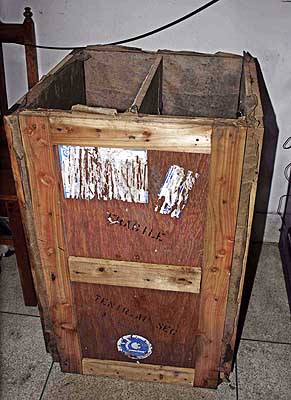 The empty crate. We had been told these were special crates that could not be opened, as they were very special. A 300 year old French company had been especially commissioned to pack the crates. The government and the French embassy decided to show improper documents rather than risk opening these special crates for proper inspection and documentation. Looks like a pretty ordinary crate to me. ? Munir uz Zaman/DrikNews
The empty crate. We had been told these were special crates that could not be opened, as they were very special. A 300 year old French company had been especially commissioned to pack the crates. The government and the French embassy decided to show improper documents rather than risk opening these special crates for proper inspection and documentation. Looks like a pretty ordinary crate to me. ? Munir uz Zaman/DrikNews
 This was a story the state owned BTV had chosen to completely ignore. The rest of the media however, despite government efforts continued to report this important story. Despite the widespread protests and the media attention, the shipment was to go ahead. Both the Cultural Adviser and the French Charge d’Affaires, emphatically promised there was no question of items going missing or not being returned. ? Munir uz Zaman/DrikNews
This was a story the state owned BTV had chosen to completely ignore. The rest of the media however, despite government efforts continued to report this important story. Despite the widespread protests and the media attention, the shipment was to go ahead. Both the Cultural Adviser and the French Charge d’Affaires, emphatically promised there was no question of items going missing or not being returned. ? Munir uz Zaman/DrikNews
b035.mp3 Interview of police officer after discovery of crate (Bangla). Munir uz Zaman/DrikNews
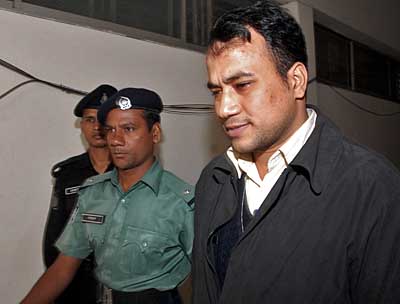 One of the arrested security officers. What of the big fish that masterminded this theft? Or the people who authorised this shipment despite the proven irregularities? ? Munir uz Zaman/DrikNews
One of the arrested security officers. What of the big fish that masterminded this theft? Or the people who authorised this shipment despite the proven irregularities? ? Munir uz Zaman/DrikNews
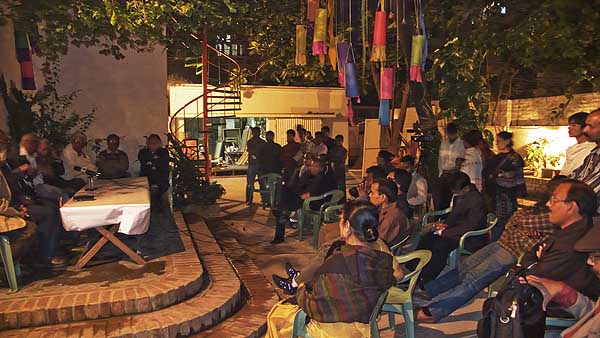 Press conference at Chitrak Gallery, where the incident has been called the most major cultural disaster of the century. ? Shahidul Alam/Drik/Majority World
Press conference at Chitrak Gallery, where the incident has been called the most major cultural disaster of the century. ? Shahidul Alam/Drik/Majority World
——–
It was the letter from Shanika, the girl I had found during the Tsunami in Sri Lanka, that reminded me of how we had forgotten all the other things that were going on. It was now Boxing Day. The Day the Tsunami had struck. Bodies are still being discovered after the Sidr cyclone. Demand for the trial of war criminals has moved off the headlines. Bodies of workers remain buried in the Rangs building rubble. It reminds me of how classed our struggles are. While we had united in protest when our archaeological heritage was being threatened, no such protest had taken place in solidarity with the workers.
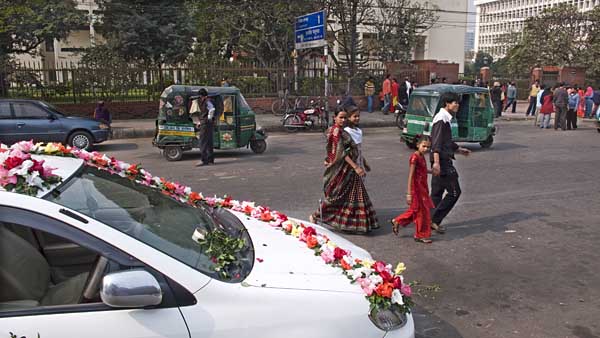 It was Christmas day, and it is the wedding season in Bangladesh. People had gathered outside the musuem, as word had spread that the remaining artefacts were being returned. It was a very different mood, and the local flower shop was using the wide road to decorate a wedding car. ? Shahidul Alam/Drik/Majority World
It was Christmas day, and it is the wedding season in Bangladesh. People had gathered outside the musuem, as word had spread that the remaining artefacts were being returned. It was a very different mood, and the local flower shop was using the wide road to decorate a wedding car. ? Shahidul Alam/Drik/Majority World
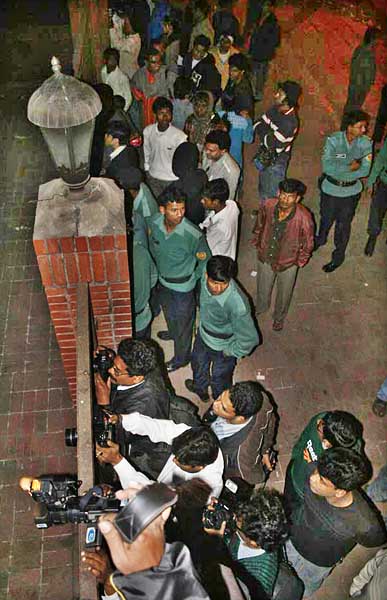 Media professionals outside museum gate watching the return of remaining 12 crates. ? Munir uz Zaman/DrikNews
Media professionals outside museum gate watching the return of remaining 12 crates. ? Munir uz Zaman/DrikNews
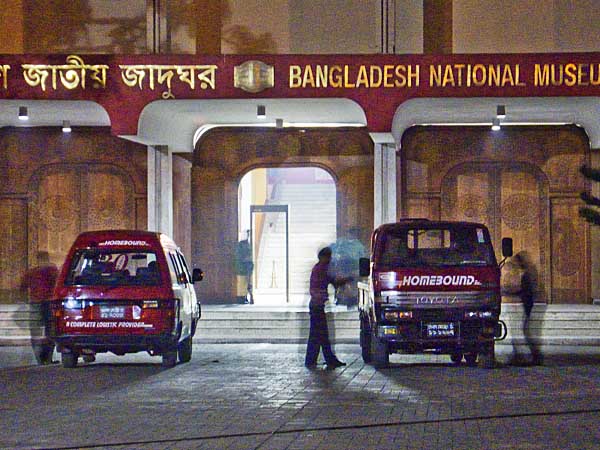 Homebound heading home. The crates are now back in the museum. The demand for reinstating them in their original location continues. ? Shahidul Alam/Drik/Majority World
Homebound heading home. The crates are now back in the museum. The demand for reinstating them in their original location continues. ? Shahidul Alam/Drik/Majority World
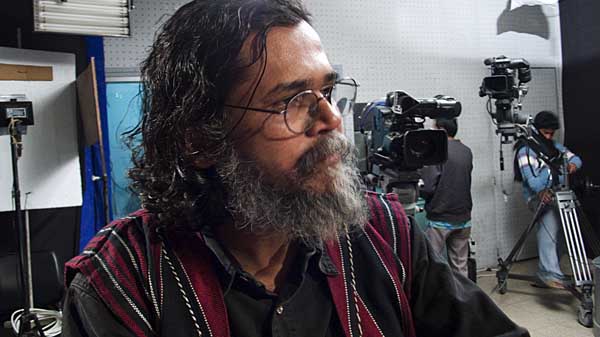 It was the vigilance of Nisar Hossain (teacher at the college of fine arts, affectionately dubbed, ‘Sector Commander’ by fellow campaigners) and his friends that led to many of the irregularities being unearthed. Nisar being interviewed on the ATN channel. ? Shahidul Alam/Drik/Majority World
It was the vigilance of Nisar Hossain (teacher at the college of fine arts, affectionately dubbed, ‘Sector Commander’ by fellow campaigners) and his friends that led to many of the irregularities being unearthed. Nisar being interviewed on the ATN channel. ? Shahidul Alam/Drik/Majority World
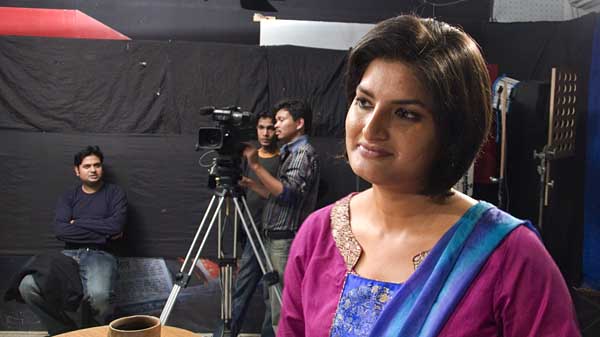 The media played an important role in keeping the issue in the public eye. Munni Saha interviewing Nisar Hossain for a programme in the ATN channel. The discussions included a clear condemnation of the French Charge d’Affaires’ statement blaming the protestors for the theft. The programme will air at 11:00 am Dhaka time on the 26th December 2007. ? Shahidul Alam/Drik/Majority World
The media played an important role in keeping the issue in the public eye. Munni Saha interviewing Nisar Hossain for a programme in the ATN channel. The discussions included a clear condemnation of the French Charge d’Affaires’ statement blaming the protestors for the theft. The programme will air at 11:00 am Dhaka time on the 26th December 2007. ? Shahidul Alam/Drik/Majority World
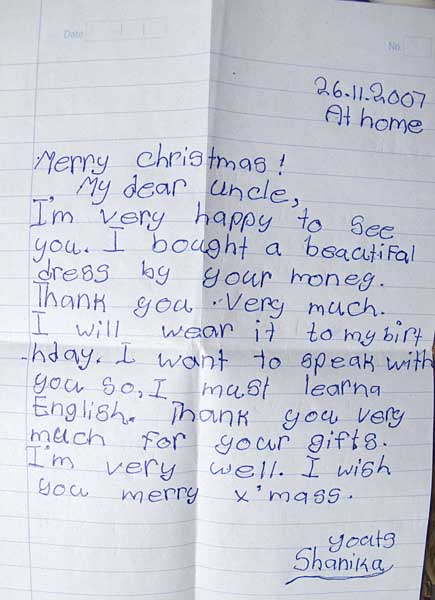 Letter from Shanika, received earlier in the month.
Letter from Shanika, received earlier in the month.
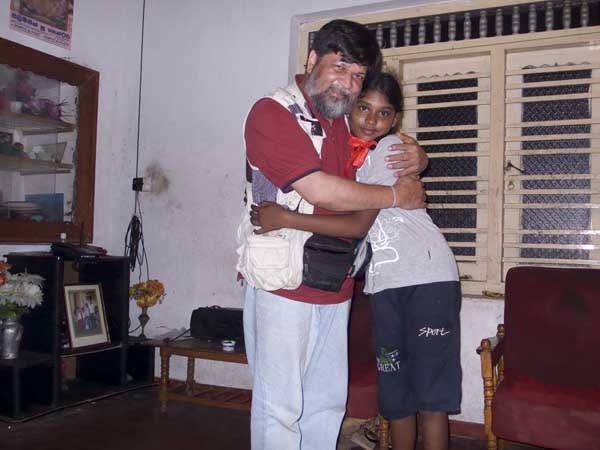 During an assignment for Help The Aged in Sri Lanka last month, I had sneaked a visit to Totagumuwa, in Hikkaduwa to see Shanika. The Tsunami had taken away her mother and her three sisters (including her twin sister). Photo: ? Priantha (Shanika’s dad).
During an assignment for Help The Aged in Sri Lanka last month, I had sneaked a visit to Totagumuwa, in Hikkaduwa to see Shanika. The Tsunami had taken away her mother and her three sisters (including her twin sister). Photo: ? Priantha (Shanika’s dad).
——-
27th December 2007
Sylvie Rebbot, the picture editor of Geo Magazine in France, just sent me this press release last night. It was issued yesterday (the 26th December 2007) by the French Ministry of Culture. While it talks about the theft of the two statues, from Zia International Airport, there is no mention of the 10 crates that are already in Paris at the Guimet Museum.
Press Release by French Ministry of Culture (26th Dec 2007)
261207-cp-expo-musee-guimet.pdf
A Flag Fails to Flutter
![]()
It was a bad day for cows
 Korbani meat being distributed outside National Museum during Eid. 21st December 2007. ? Shahidul Alam/Drik/Majority World
Korbani meat being distributed outside National Museum during Eid. 21st December 2007. ? Shahidul Alam/Drik/Majority World
But the Bangladesh government had a supreme sacrifice in mind. When the most prized of your possessions needed to be sacrificed, and when the gods have changed to western powers, the four-legged creatures simply wouldn't do. The nation's most prized archaeological possessions were therefore bundled away in Homebound chariots to distant museums. The door to heaven's gate might not have opened, but a Schengen visa and perhaps a few trips to Paris for some, had surely been assured.
It was well timed. The Eid holidays meant there would be no newspapers for two days. Most reporters would be away. The streets of Dhaka would be empty. Holidays meant there was no rush. No pesky public to worry about at opening hours. Still one needed to be sure. Bus no Dhaka Jo 11 1767, was on standby with riot police. The police jeep Dhaka Jo 11 4364 followed behind. Then the media that got in the way. With so many Eid events to cover, why had they gathered round the national museum? The sanctity of sacrifice should surely have been respected. Reinforcements in the form of another busload of riot police came in via bus number Dhaka Jo 14 1799.
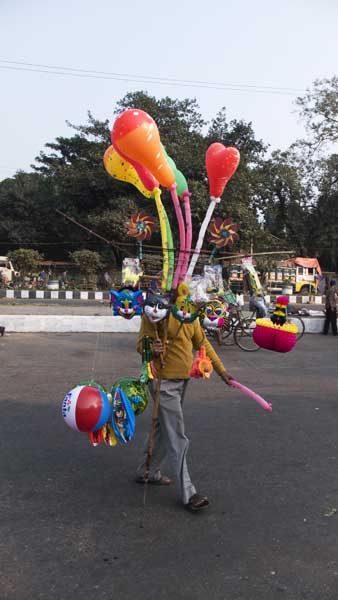 Balloon man outside National Museum. Friday 21st December 2007. ? Shahidul Alam/Drik/Majority World
Balloon man outside National Museum. Friday 21st December 2007. ? Shahidul Alam/Drik/Majority World
 Family out on Eid. Friday 21st December 2007. ? Shahidul Alam/Drik/Majority World
Family out on Eid. Friday 21st December 2007. ? Shahidul Alam/Drik/Majority World
 Aisha outside National Museum. ? Shahidul Alam/Drik/Majority World
Aisha outside National Museum. ? Shahidul Alam/Drik/Majority World
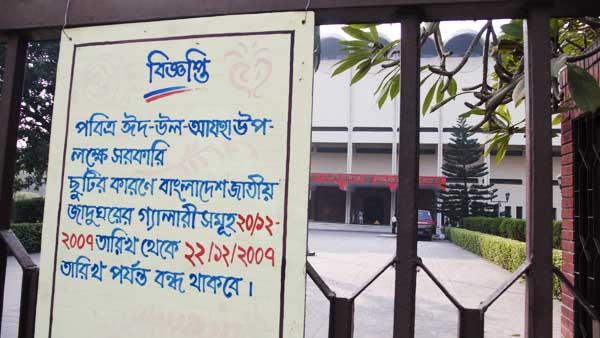 Sign says the museum is closed from the 20th till the 22nd on account of Eid. Friday 21st December 2007. ? Shahidul Alam/Drik/Majority World
Sign says the museum is closed from the 20th till the 22nd on account of Eid. Friday 21st December 2007. ? Shahidul Alam/Drik/Majority World
Aisha had come with her parents to visit the museum. Like many others they were turned away. The museum was closed, at least to the public. The Eid holidays of museum officials had however been cancelled. The shippers were working overtime.
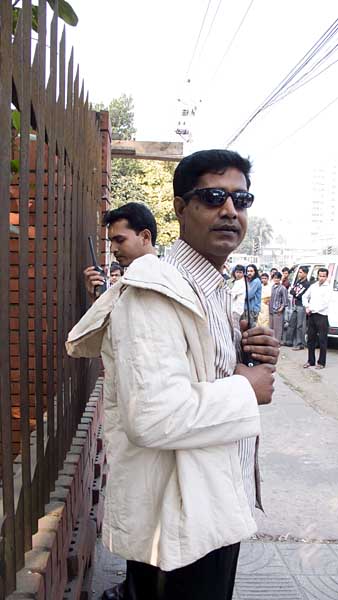
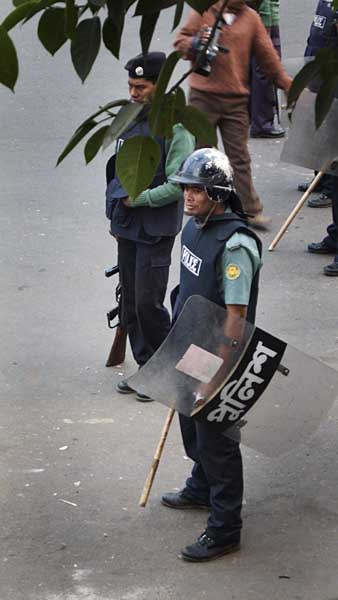
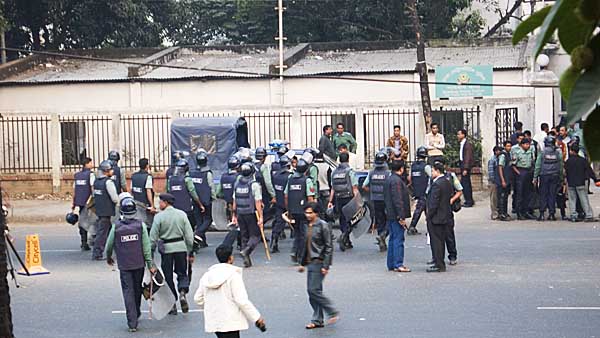 Police returning to station, after staging the 'escape'. ? Shahidul Alam/Drik/Majority World
Police returning to station, after staging the 'escape'. ? Shahidul Alam/Drik/Majority World
Police and plainclothes intelligence officials were present in abundance, their riot gear jarring with the bright new clothes of Dhakaites. Then it took another turn. Spitting and booing had failed to stop the Homebound trucks earlier. This time the protesters changed tack. Chains were put on the gate of the national museum. Visions of the Chipko Resistance
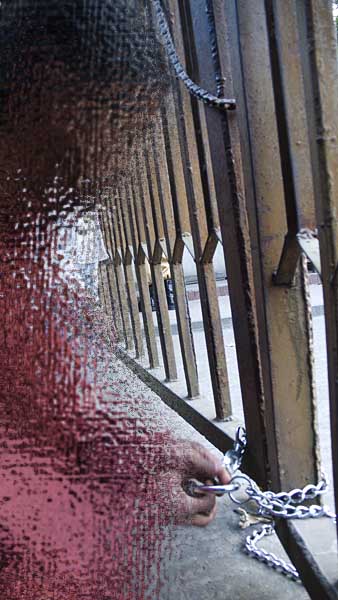 Protester chaining front gate of National Museum. Friday 21st December 2007. ? Shahidul Alam/Drik/Majority World
Protester chaining front gate of National Museum. Friday 21st December 2007. ? Shahidul Alam/Drik/Majority World
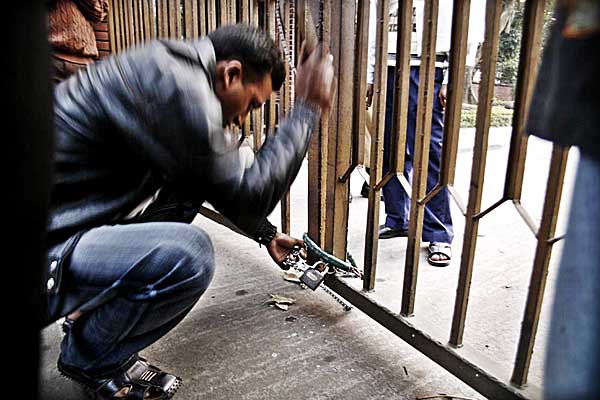 Police breaking padlock at front gate of National Museum. Friday 21st December 2007. ? Gazi Nafis Ahmed/DrikNews
Police breaking padlock at front gate of National Museum. Friday 21st December 2007. ? Gazi Nafis Ahmed/DrikNews
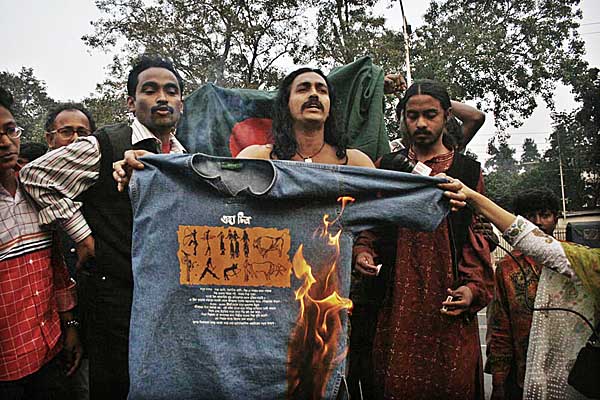 Burning shirt in protest outside National Musuem. Friday 21st December 2007. ? Munir uz Zaman/DrikNews
Burning shirt in protest outside National Musuem. Friday 21st December 2007. ? Munir uz Zaman/DrikNews
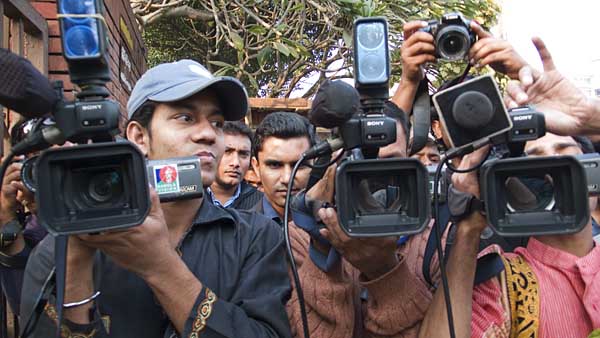 Despite emergency rule and government efforts to bury the story, media continued to give the event full coverage. ? Shahidul Alam/Drik/Majority World
Despite emergency rule and government efforts to bury the story, media continued to give the event full coverage. ? Shahidul Alam/Drik/Majority World
sprang to mind. In place of burglars breaking in, the comic view of government officials breaking their way out of the national museum to escape with museum valuables would have brought laughter in a trirotno drama (popular Bangladeshi sitcom). In the theatre of Bangladeshi governance, it was yet another tragedy.
"The benefits, for both countries, are cultural: it is a win-win situation where France gains a better knowledge of Bangladeshi heritage and Bangladesh gains a better image on the international cultural scene," the French embassy handout had clarified.
The partially demolished Rangs building continues to be a grave for the buried Bangladeshi workers far down the priority chain. Presumably, that is a 'Bangladeshi heritage' the Parisians will not get to see.
The last time round, they had been playing one of my favourite Bhupen Hajarika songs. This time there was no music, and no one was smiling. Even the Bangladeshi flag failed to flutter on this Eid day. Video of trucks carrying artefacs out of museum. ? Shahidul Alam/Drik/Majority World
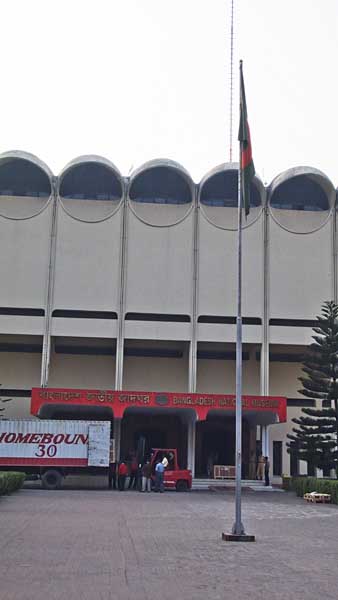 embed> Bangladeshi flag refuses to flutter as prized Bangladeshi objects are taken out of museum. ? Shahidul Alam/Drik/Majority World
embed> Bangladeshi flag refuses to flutter as prized Bangladeshi objects are taken out of museum. ? Shahidul Alam/Drik/Majority World
Video of trucks carrying artefacs out of museum.
It Should Not Have Happened
![]()
Why should the poor always have to pay for the misdeeds of the government, of the rich?
This question surfaced yet again when I stood outside Rangs building on the morning of Dec 12.
Rangs, one of the largest business houses in Bangladesh, had their building plans approved by Rajuk (Rajdhani Unnoyon Kortripokkho, i.e., Capital Development Authority), and they built a huge edifice. Approval for high rises are generally not given in this area due to flight restrictions. Six storied buildings are the limit. However, Rangs built a 22 storied building which no one could miss. Except Rajuk, of course.
That is how things stood until the present caretaker government came into power and rushed headlong into its drive against corruption.
? Which officials in Rajuk had okayed these plans? And why? That has remained a secret. Has anyone in Rajuk been punished for approving these plans?
? The Supreme Court ordered the demolition of the building, and Rajuk appointed Six Star, a ship-breaking company to carry out the work. Who made the decision? On what basis? What qualifications did Six Star have? Was any corruption involved? If so, will those involved be tried?
? After the demolition disaster, Six Star, Rajuk, Rangs — will they be made accountable for their misdeeds?
Is a life worth only one lakh taka — the sum that the government will pay as compensation for those who have died?
‘They don’t give us our dead’
An elderly man sat 50 feet away from the Rangs building on a second floor veranda of a shopping market. After the innards of the building had collapsed, many workers had taken shelter in this veranda. The elderly man had come to Dhaka early this morning with his son-in-law, in search of his son’s body. He muttered something when I asked him if he had spoken to anyone here. I couldn’t make sense, and repeated my question. I could barely make out what he said, “They don’t give us our dead.” He told me he had come from Gaibandha, and I thought to myself, now we can be sure that one of those who have died is from Gaibandha.
A woman has rushed over from Modhukhali. Her brother has suffered a head injury. But thankfully, he is alive, and he will live. At least ten people from Modhukhali are thought to have died in the demolition disaster.
Hajari, one of the workers hired for demolition said, one of the building’s security men is missing. He had last been seen on one of the topmost floors of the building. “It all happened in less than 30 seconds.” Hajari and the other workers had scrambled down the floors to save themselves.
I spoke to some of the workers and it seemed that no one from Rajuk or Six Star, at least not any one in a position of authority had contacted them, or spoken to them, let alone reassured them. Class distances are such that the workers themselves had not gathered the courage to talk to Rajuk officials.
Six Star company, Hajari told me, had brought the main group of workers from Chittagong. Being a port city, Chittagong is a place where people from different parts of the country migrate to in search of work. Hajari’s home is Barisal but he has lived for many years in Chitagong. “Six Star,” he said, “they will provide compensation. They are ever-ready. In Chittagong dock, every month you get to see one or two workers die, such accidents keep happening.” Most of those who had survived the Rangs disaster had been sent back by Six Star. Only 50 workers had been kept back for the rescue effort.
Six Star was paying the workers daily wages and also providing meal charges. From tonight (Dec 12) , the company would also arrange workers’ boarding. This is what Hajari had told me but when I spoke to two other workers, they said they were not being paid their regular wages. Neither were labour shordars giving them money to buy food.
On the market verandah I came across another worker, who was released yesterday from Dhaka Medical College. He had received back injuries, so said the hospital slip. He did not have the money to buy the medicine that had been prescribed. Painkillers on an empty stomach would do him more harm than good. He told me that he had slept on a thin sheet of cloth the night before, and that his pain had increased.
An old story of anguish and suffering
As we talked with the workers and their relatives, I noticed an elderly, bearded man speaking nearby. He was noticeably agitated. I took him to be a demolition worker. I moved closer to where he stood and heard him say, “If they had been the sons of MPs and Ministers, would the dead bodies have been left hanging? People would have been running around breathlessly. We are cchotolok, why should anyone bother?” I later found out that he didn’t work for Rangs, that he worked somewhere else nearby. Listening to him was like listening to a broken record. I was reminded yet again of how helpless poor people are.
It should not have happened. It should not have been allowed to happen. It is something that should have caused a government’s downfall. It is amazing that such things keep happening. Almost daily. And ceaselessly.
Newspaper reporting
At home, we read Prothom Alo. In terms of reporting, it is one of the finest newspapers in the country. I quickly skimmed the reportage on Rangs, once again today. None of the reports focus on who is to blame for the disaster, they tend to highlight the accident-al nature of the disaster. I see an editorial, but I do not have the time to read it. Those who read other newspapers will know how it has been reported in other dailies. Some may cite cyclone Sidr, or the harassment of university teachers as reasons for such reporting but I find it difficult to agree. I think the un-focused reporting is deliberate.
But I must not be too harsh. After all, it is news reporters who keep the story alive as those who are guilty hide behind screens of authority.
People’s distrust
Tonight I have learnt that 14 coffins have been taken inside. Since then, family members of the workers have refused to leave the area. Many of them think that the authorities will get rid of the bodies. They have come from outside Dhaka, they do not belong here, they have no networks of familial or social support in this city. They can only gather and resist with whatever they have.
Will the authorities really get rid of the dead bodies? Will they not hand over to grieving family members the bodies of their beloved ones? You may think I am jumping to conclusions but it is true that the whole process is shrouded in secrecy, and that those in authority are trying to save their skin.
Yesterday afternoon as I stood outside Rangs Bhaban, I could catch the faint smell of decomposing bodies. The smell will get stronger. Fire Brigade workers, who are on standby, do not know when rescue efforts will begin.
I belong to the ranks of the ordinary people, I belong to those who are toothless and clawless. Yet I cannot help but think, those who are guilty must not be allowed to get away. At least, not this time.
Priscilla Raj
1:00 am
Dec 13, 2007
[translation: rahnuma ahmed]
Bangladeshi journalists Priscilla Raj and Saleem Samad, who had worked for the Channel 4 team as interpreter and fixer, respectively, were also detained and charged with involvement in ?anti-state activities.? Raj was released on bail in December 2002.
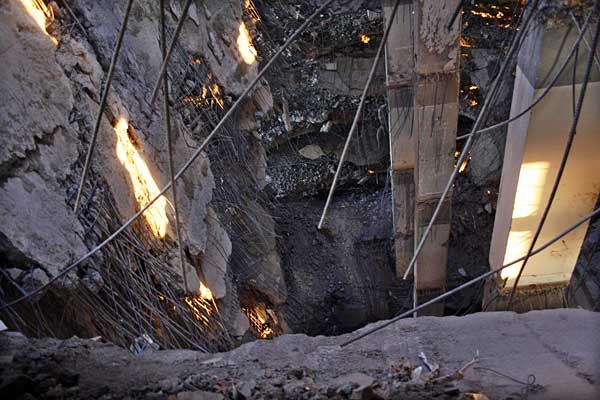 Collapsed floor of Rangs Building. December 9. 2007 ? Munir uz Zaman/DrikNews
Collapsed floor of Rangs Building. December 9. 2007 ? Munir uz Zaman/DrikNews
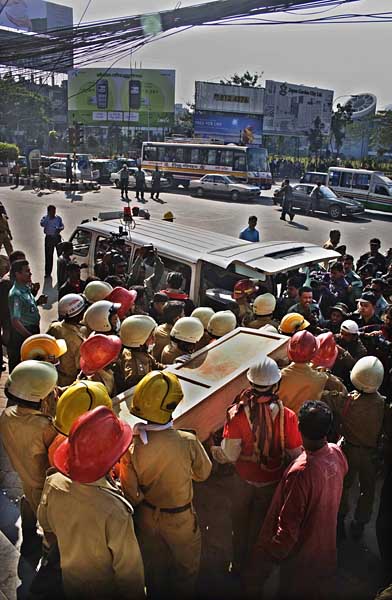 Body released by Fire Brigade being sent to morgue. ? Azizur Rahim Peu/DrikNews
Body released by Fire Brigade being sent to morgue. ? Azizur Rahim Peu/DrikNews
We rushed as soon as we received the tip off, sneaking away from our workshop on “Investigative Journalism for Television.” Working our way round the devotees praying on Panthapath we rushed to the National Museum.
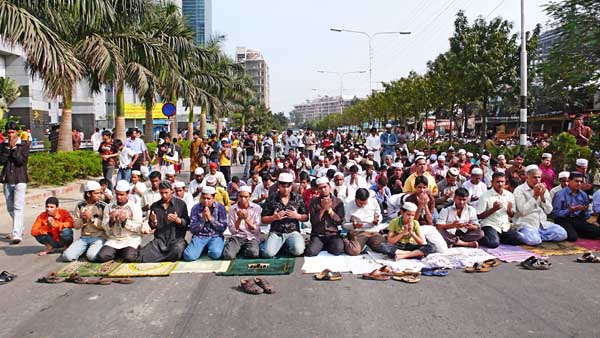 Jumma prayers on Panthapath. Friday December 7. 2007. ? Shahidul Alam/Drik/Majority World
Jumma prayers on Panthapath. Friday December 7. 2007. ? Shahidul Alam/Drik/Majority World
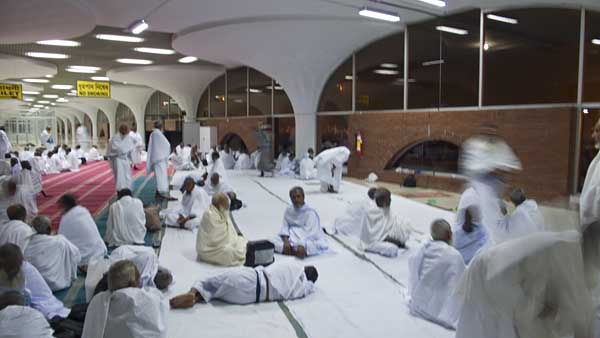 Hajis at Zia International Airport. Saturday December 8. 2007. ? Shahidul Alam/Drik/Majority World
Hajis at Zia International Airport. Saturday December 8. 2007. ? Shahidul Alam/Drik/Majority World
It was a false alarm. The trucks had left, and the artefacts that were still left in the National Museum were safe. At least for the moment. The remaining week, my book launch in Glasgow,
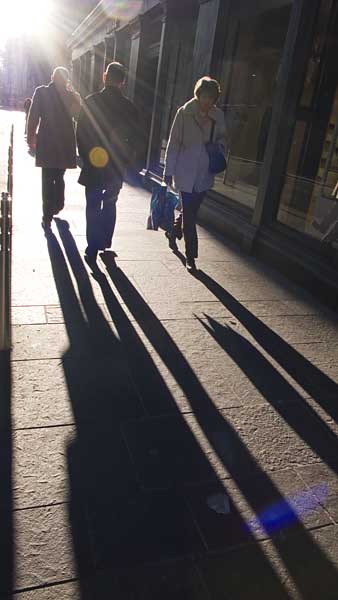 Glasgow. December 10 2007. ? Shahidul Alam/Drik/Majority World
Glasgow. December 10 2007. ? Shahidul Alam/Drik/Majority World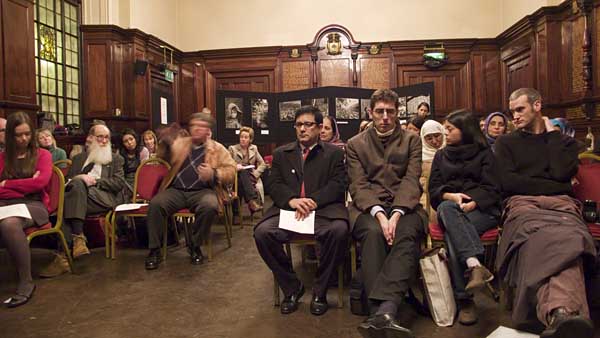 Glasgow. December 10 2007. ? Shahidul Alam/Drik/Majority World
Glasgow. December 10 2007. ? Shahidul Alam/Drik/Majority World
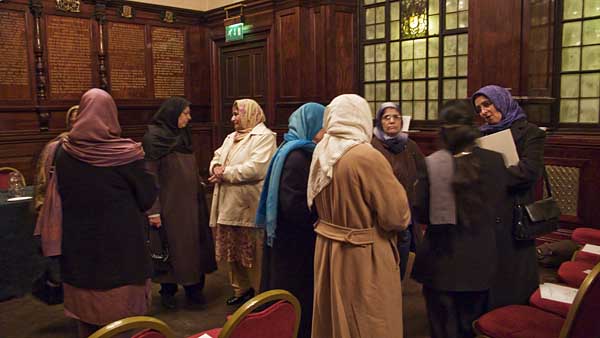 Glasgow. December 10 2007. ? Shahidul Alam/Drik/Majority World
Glasgow. December 10 2007. ? Shahidul Alam/Drik/Majority World
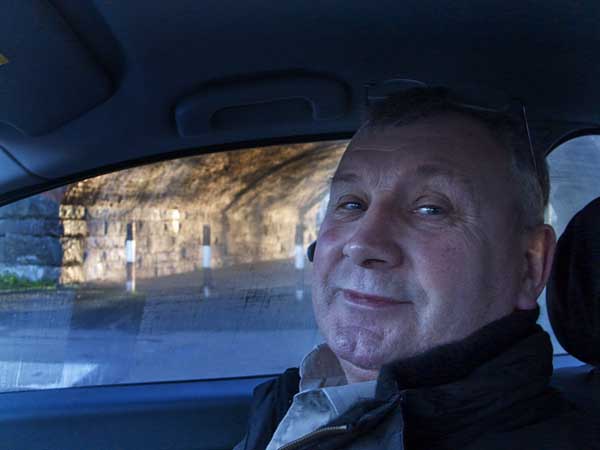 Taxi driver Robert who had worked at Port Glasgow. Ships later taken apart in Chittagong, Bangladesh, started their journey here. December 10 2007. ? Shahidul Alam/Drik/Majority World
Taxi driver Robert who had worked at Port Glasgow. Ships later taken apart in Chittagong, Bangladesh, started their journey here. December 10 2007. ? Shahidul Alam/Drik/Majority World
the Prince Claus Fund Award ceremony in Amsterdam and the conference “Visible Rights” at Harvard, took me from a sunny afternoon in Scotland to the snow covered streets of Cambridge.

Though Jon Husband had helped me setup my blog, I had never met him before. Jeroen picked me up at Schipol, and Jon, Jeroen and I had dinner at the Bazar Middle Eastern restaurant in Amsterdam. December 10. 2007. ? Shahidul Alam/Drik/Majority World
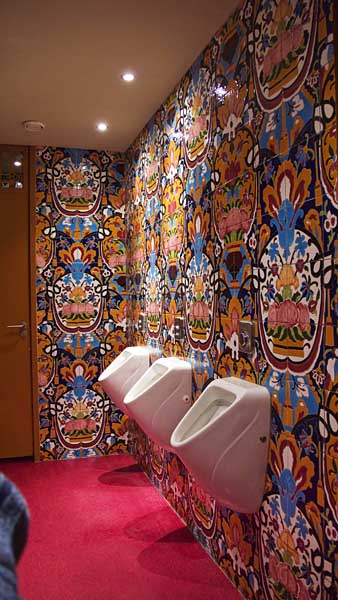 The ornate loo at the Bazar Middle Eastern restaurant in Amsterdam. December 10. 2007. ? Shahidul Alam/Drik/Majority World
The ornate loo at the Bazar Middle Eastern restaurant in Amsterdam. December 10. 2007. ? Shahidul Alam/Drik/Majority World
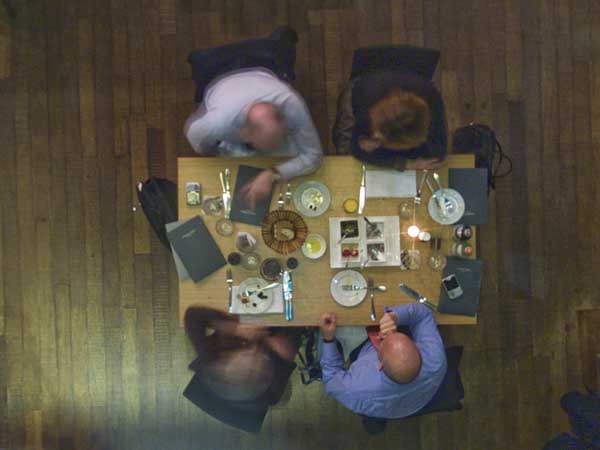 Diners seen through the glass floor at Muziekgebouw. Amsterdam. Dec 12. 2007. ? Shahidul Alam/Drik/Majority World
Diners seen through the glass floor at Muziekgebouw. Amsterdam. Dec 12. 2007. ? Shahidul Alam/Drik/Majority World
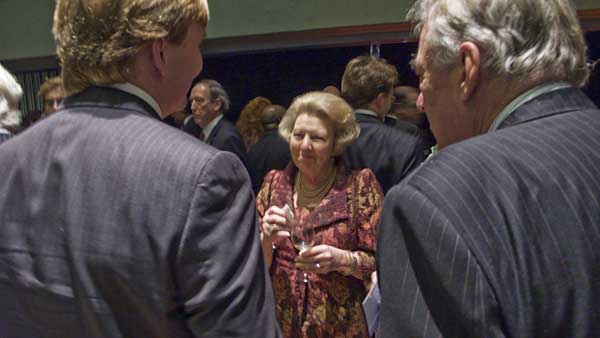 Queen Beatrix at Prince Claus Fund Award Ceremony at Muziekgebouw. Amsterdam. Dec 12. 2007. ? Shahidul Alam/Drik/Majority World
Queen Beatrix at Prince Claus Fund Award Ceremony at Muziekgebouw. Amsterdam. Dec 12. 2007. ? Shahidul Alam/Drik/Majority World
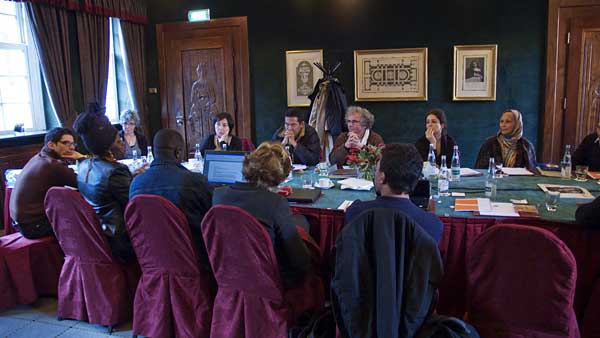 Network meeting of Prince Claus Fund at Grand Hotel, Amsterdam. December 13th 2007. ? Shahidul Alam/Drik/Majority World
Network meeting of Prince Claus Fund at Grand Hotel, Amsterdam. December 13th 2007. ? Shahidul Alam/Drik/Majority World
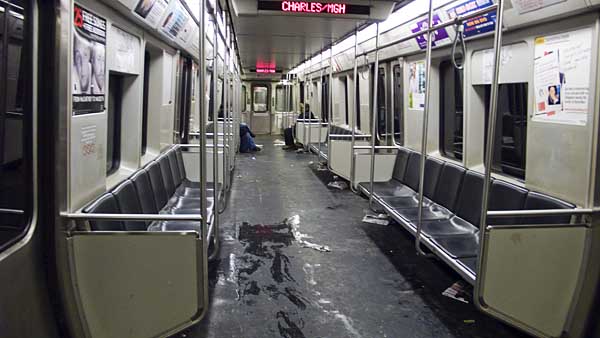 Train at Boston December 14. 2007. ? Shahidul Alam/Drik/Majority World
Train at Boston December 14. 2007. ? Shahidul Alam/Drik/Majority World
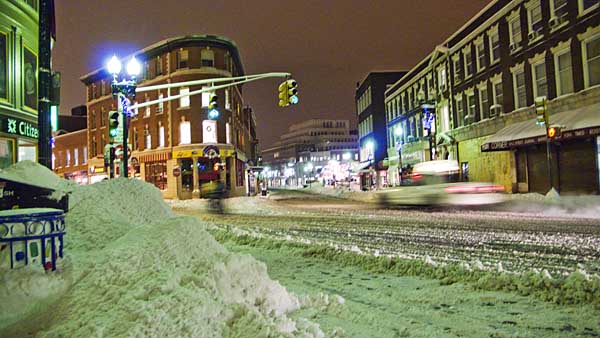 Outside Harvard train station at 2:00 am. December 14. 2007. ? Shahidul Alam/Drik/Majority World
Outside Harvard train station at 2:00 am. December 14. 2007. ? Shahidul Alam/Drik/Majority World
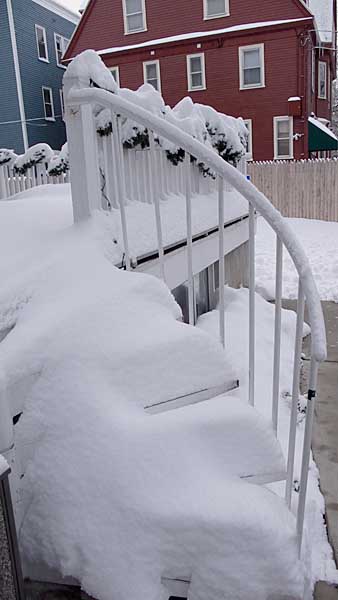 Stairs at Irving House. December 14. 2007. ? Shahidul Alam/Drik/Majority World
Stairs at Irving House. December 14. 2007. ? Shahidul Alam/Drik/Majority World
There was good news in between. The Rajshahi University teachers being released was a great relief, but the deaths of workers at Rangs Building, and the slum fire in Begunbari reminded me how far my own life was from the reality of workers and slum dwellers of my land.
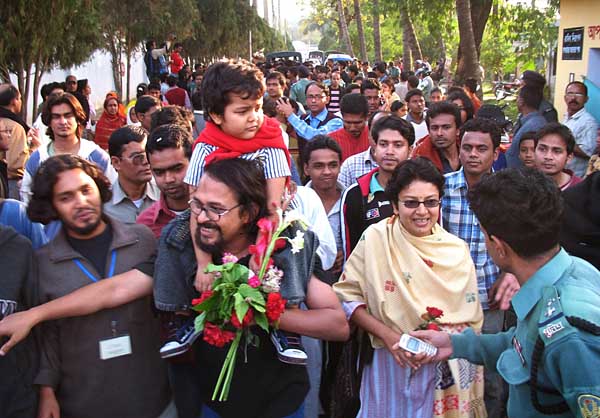 Detained Rajshahi University teachers, released after being granted a presidential pardon. December 10. 2007. ? Iqbal Ahmed/DrikNews
Detained Rajshahi University teachers, released after being granted a presidential pardon. December 10. 2007. ? Iqbal Ahmed/DrikNews
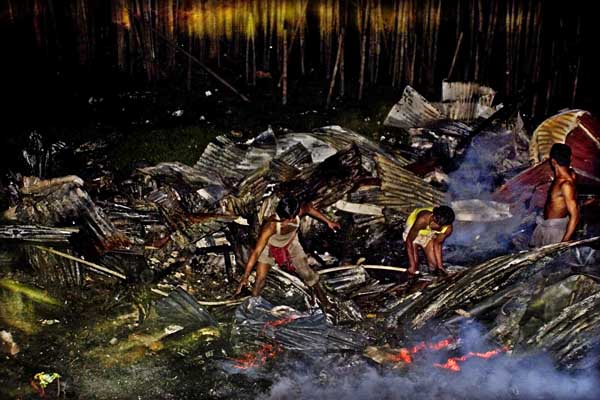 Fire in Begunbari slum. December 15. 2007. ? Zaid Islam/DrikNews
Fire in Begunbari slum. December 15. 2007. ? Zaid Islam/DrikNews
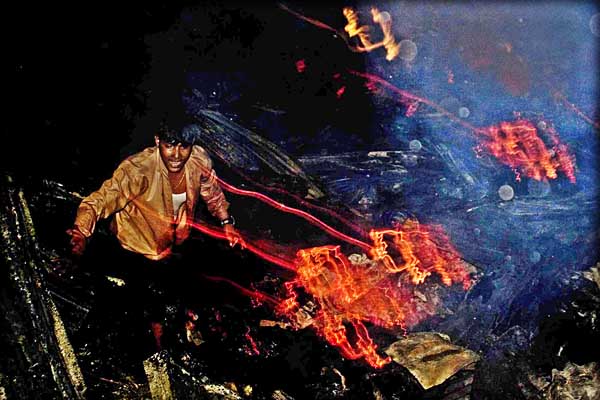 Fire in Begunbari slum. December 15. 2007. ? Zaid Islam/DrikNews
Fire in Begunbari slum. December 15. 2007. ? Zaid Islam/DrikNews
While the gatekeepers who rule our land remain untouched by the death of the poor. While media houses remain in the hands of wealthy business people. While opulent adverts by Grameen, Banglalink and Warid influence what gets reported in mainstream, the lives of media professionals like Priscilla Raj, Tipu Sultan, Probir Shikdar and Tasneem Khalil will continue to be under threat, The war criminals supporting the Pakistan Army had killed our intellectuals on the month of victory in 1971. December has another meaning for the workers and the slum dwellers who live under different military rulers.
The Candy Man
![]()
He was charming, witty, and took blame upon himself. Adviser Ayub Quadri, was the Minister of Education, Minister of Primary and Mass Education and Minister of Cultural Affairs, Government of the People?s Republic of Bangladesh. He was the perfect guy to rely upon for damage control. The public school background showed, as did the many years as a top bureaucrat. He had been a member of the elite Civil Service of Pakistan (CSP). An old boys network that still holds clout in the subcontinent.
The Press Information Department (PID) auditorium on the 3rd floor of Building 9, in the Bangladesh Secretariat was packed. Unlike many other Bangladeshi events this press conference started on time. Squeezing through the footpaths, crossing fences, lifting my bicycle over rickshaws stuck in traffic, I had panted my way to the secretariat. The police at gate 2 had been too perplexed by a bicycle going through the gate to even stop me for papers. I arrived just as the first question was raised. It was a packed hall, and while I thought I would stay at the back, I realised that I needed to get up there to stand any chance of getting a question in. I sat on the floor in between the video tripods.
The journalists had done their homework. And while there were a few questions that were repetitive, by and large, they knew what they wanted. In response to a question about the alleged corruption charges against one of the government officials involved in the transaction, the adviser joked. “Well I am the person in overall charge. The police don’t seem to be after me for corruption.” Pretty answer. Pity it didn’t answer the question.
The large table with the adviser in the middle was imposing. The Secretary of Culture on the left and another officer on the right played a largely ornamental role. So did the entire row of officials in the back. They did however lean forward to whisper in the adviser’s ear from time to time. The question came up of the alleged transportation of the bronze casket in 1959 to France, which Mr. Zakaria, the ex Secretary of Culture had mentioned in a press conference on the 1st December. The adviser let the question slip, saying he’d heard of such accusations and was looking into it. A member of the back row broke ranks and retorted, “There is no such record.” Mr. Zakaria, also an ex director of the department of archaeology, had mentioned a 49 year fight to get back this prized possession, without success. A journalist mentioned the case of the 30 paintings of Mohammad Younus. They had been sent to Yugoslavia, on a government to government exchange. None had ever come back. Quadri again said he didn’t know. “Don’t know” was quite a common response to questions. Candid perhaps, but not particularly useful.
In answer to the questions about the irregularities regarding the loan inventory, the adviser did provide figures, but no documents he could back them up with. Questions from the floor pointed to the disjoint between the figures he quoted and the ones given in the government documents submitted to the court. That they didn’t correspond to the inventory produced by the French themselves. He promised to provide updated documents this very evening. Tomorrow morning at the latest. Why the government had provided documents to the court which did not tally with the shipment, was a question that never got asked, and was certainly not clarified. The mystery of calling a press conference, but not having these documents at hand was never solved by the guests.
“I have full confidence that the items will come back.” He said, taking the weight of the world on his shoulders. As to why Bangladeshis should have confidence in him, was one that was never clarified.
“The company that had packed the crates have been doing so for 300 years,” he mentioned. The doubters have been asking for the packers to be named ever since the beginning, but have not been given an answer. Those who had thought the press conference would enlighten them were disappointed.
Since only government members of the committee were present, there was no one to question the claim that everything had been done to please the committee. That the committee had been fully satisfied with the proceedings. The fact that the official letter by the committee, in the hands of the press, said something entirely different was a mere technicality.
The inconsistencies were the problem. We still don’t know exactly how many items are being sent. Neither do we know exactly what is being sent. The few specifics the advisor provided, that there were “50 silver coins, and 8 gold coins,” might have helped in purchasing supplies for an Everest expedition, but didn’t help much in evaluating either the value, or the specifics of a museum item. Especially when the court record states “50 punchmarked coins” in one entry and an unspecified number of “gold and silver coins” in another. Assuming the number of silver coins in the latter entry is non-zero, and that the punchmarked coins are all silver, we still have a problem. The French inventory specifies “93 punch marked coins.” Are the “gold and silver coins” non-punchmarked? Do they add up to the “8 gold coins” the adviser was referring to? 50 + non-zero number = 50 and 50 + 8 = 93 in Ayub Quadri’s arithmetic.
There are bigger issues. He generally accepted that the insurance value was low, but claimed that it was an academic issue in the case of priceless items. Especially since he was confident that they were all coming back. However the French press release, issued on the 25th September 2007, stated that the insurance value was 4 million euro. The adviser today clearly stated 2.6 million euro. So who are we to believe? We are after all talking of the most prized possessions of a nation. Consistent statements help remove doubt. The adviser’s “confidence” might work on a poker table, but does little to put a worried population at ease.
He brushed off the accusation about whisking off the items in a hurry, or that there was any question of impropriety or stealth in terms of going against court directives. When asked why such an important event, which was covered by all major independent media, was completely unreported on state television, he smiled. The gentleman on the right did speak up this time. He pointed out that the question was “irrelevant.”
Other questions remain. Gold and silver coins is one thing. In the documents presented to the court by the government, even one of the most valued items, the large (and extremely rare) bronze statue the Vajrasattva does include an insurance value (not always the case for other items listed) of 200,000 euro. This item too does not have an accession number.
Quadri was unruffled throughout, never losing cool. Always extremely pleasant. His only admission to some concern was in answer to a question about when the items would come back. He said in no uncertain terms, “April.” He added, “Until then, I will stay worried, and looking at the mood in the room, I can tell that you too will not rest.” I hope he meant 2007.
As a child, we would watch the candy floss man take a tiny spoonful of sugar, a dollop of colouring and would watch with amazement as the machine spun out a pink web, which he would twirl around a stick. One portion was only dui poisha (two paisa). A figure which we could realistically save up. The large pink fluff, folded on contact, and melted in the mouth, but did give a sense of attainment. We called it hawai mithai, sweet made of air. This candy floss press conference too, had little substance but plenty of form.
Whether the media kids will feel they got value for their dui poisha is something we’ll see in tomorrow’s headlines.
3rd December 2007. Dhaka.
———
Previous governments have killed farmers when they demanded fertilisers and seeds. Villagers have been killed when they had the audacity to demand electricity, resist open pit mining. Yesterday 14 cyclone affected people were detained for trying to present a memorandum demanding relief. We wonder what demands for saving our heritage will bring.
The Missing Piece of the Jigsaw
![]()
The battle lines appear to have been drawn. Guimet is a respected museum, and there has been natural interest in a show that should be very special. Why then such resistance from art lovers of Bangladesh? Surely art is to be appreciated? It is part of our identity and an important part of the image we portray. Why on the other hand, the secrecy? The organisers should be taking credit for arranging such an event and not trying to sneak away under police protection. If there is nothing to cover up, why the covert operation?
The emotions are high. I’ve seen people weeping because something very special to them has been taken away. I have seen people angry because they feel violated. I have seen people frustrated, because they feel helpless against the power of the establishment.
As a journalist I need to be wary. It is important to separate the emotions from the facts. To not let friendships sway one’s judgement. To apply journalistic rigour in one’s analysis regardless of whether one agrees with the outcome of one’s research.
So let’s separate the facts from the opinions.
The Guimet is a respected museum known and admired. The protesters are respected citizens with a high level of credibility. Questions have been raised about both entities, which we need to address further, but there appears to be a gap in the puzzle, which no one so far has discussed. The answer could perhaps provide a vital clue.
What was the motive behind the exhibition and who initiated it? Who are the stakeholders? The interest of Guimet is understandable. Leaving aside the accusations for the moment, an important museum specialising in non western art would surely have an interest in such a prized exhibit. But would a museum, knowing there is so much resistance, and bad press, insist upon such an exhibit coming, when so many other options are available? Major museums are usually booked way in advance. The opening dates for this one is also well past. We have Christmas and New Year coming up. Setting up the show, once the entire shipment has arrived, will take another three weeks by the director’s own admission.
We have been repeatedly told that the event is in the interest of promoting the image of Bangladesh abroad. Having put in the huge amount of work and expense that has gone into the curatorial process, does it really make sense for the French Government and Musee Guimet to take on such flak? Does it make sense for the French Government and the Museum officials to demonstrate their love for Bangladesh, when Bangladeshis themselves are opposing the event so vociferously?
While exploring these options I have come across several opinions. One states “The truth is that that some quarters in Bangladesh are upset that the items to be shown are Hindu art artifacts and that this exhibition is going to send the wrong image of Bangladesh to the French public: that Bangladesh, a majority Muslim country, has a strong Hindu culture and art history. This is the real story not the bullshit that has been published. How come knowledgeable sources in Dhaka write to me to tell me what they know for sure and not to you?”
Another friend said “The majority of the works are fakes, and taking the show to the Guimet would reveal this fact, exposing the perpetrators. Hence the resistance.” This too is attributed to knowledgeable sources. None of the people who tell me these stories will reveal who these knowledgeable people are.
Sitting in the comfort of the French Ambassador’s residence we heard him say, “Some people who wanted a good image of Bangladesh had promoted the exhibition.” By implication, this was something the protesters were not inclined towards. So the love of the nation, or lack of it was his criterion for determining which side of the divide one would stay. And who are they? He too was reluctant to reveal who these good people were. I suppose good people are by nature modest, and unwilling to take credit for their virtue.
It doesn’t take deep analysis to see that none of the accusations hold. So we are still grappling with the motive. Not of Guimet itself, but of the ‘some’ people that the French Ambassador has repeatedly alluded to.
There was another event “Sonar Bangla Fair” which was planned as a conjunct to the Guimet exhibition. While both the government and the French embassy have denied direct ties to this event, it is clear from the many circulars and press releases that have gone out, that the Guimet exhibition was part of a package. The extensive lobbying, the pressure applied to media houses, and the behind the scenes manoeuvres through which people have been told to ‘drop’ the case, has come not so much from the French, but from highly placed Bangladeshis. Is it their love of Bangladesh that is the driving force? Is love for their country something they should be so secretive about?
The protesters have been very open about their position and have stated so through their physical actions and their statements. Independent bloggers from both sides of the camp have expressed their opinions openly. Why have the promoters of this exhibition, with access to both the government and the embassy, chosen to work strictly under cover? The planning for this exhibition has been going on for a long time. As in many a Bangla romance, the promoters’ unrequited love has been a well kept secret, but it has survived a change of government.
The recent statement by prominent citizens to the French Government, shows a disturbing turn in the position taken by the protesters. “While we were originally open to the idea of showing the work at Musee Guimet provided the transparency issues were addressed, the recent actions of the museum has removed any semblance of trust in the organisation, and we are no longer willing to loan our prized possessions to an organisation with such standards of behaviour. The incident, originally restricted to the issue of an exhibition now appears to have created a general distrust in the French government amongst the Bangladeshi public.”
How come these well wishers of Bangladesh risk alienating the very public that they love so dearly, but are still shy about declaring the love for their country?
I believe one important word that has so far not been uttered is ‘money’. What is the ‘package’ that the Guimet exhibition falls under? How much money is involved? Who are the beneficiaries, and how were they chosen? Who are they affiliated to?
The government in power has made corruption their number one target. Business people, prominent politicians and even ordinary citizens have been asked to declare their assets and their links to financial ventures. Perhaps it is time for the government to ask all the people who are linked with Masterpieces of the Ganges Delta exhibition, the Sonar Bangla Fair and all the ancillary events to declare the extent of their association and the monetary value that such association brings. Citizens have been asked to help the government by reporting any suspected cases of corruption. With activities of the Ministry of Culture itself in question. With the government appointed committee complaining of non-cooperation by Culture ministry officials. With people chanting chor chor (thief, thief) in the streets outside a public institution, why has the government suddenly gone blind? Have the sniffer dogs of corruption, who bark at the slightest whiff of a nexus, suddenly lost their sense of smell? Or would that be a same side (own goal)?
Perhaps this piece of the jigsaw will help us see the full picture.
—————————————————————————
12:40 am 3rd Dec. The Government has finally responded. Press conference called by the Ministry of Culture at 12:00 pm. Building 9. Bangladesh Secretariat.
